NAMES OF THE WEEK from: 2013 2014 2015 2016 2018 2019 2020 2021 2022 2023 2024 2025
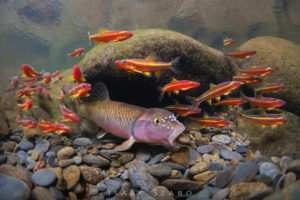
A River Chub, Nocomis micropogon, build his nest, while Saffron Shiner, Notropis rubricroceus, gather to spawn over it. Photograph © Isaac Szabo.
24 December 2017
Nocomis micropogon and Notropis rubricroceus
To celebrate the holidays and close out 2017, we are pleased to share one of the most amazing fish photographs we’ve ever seen. It shows a male River Chub, Nocomis micropogon, his head adorned with breeding tubercles, adding a rock to his nest, while a shoal of Saffron Shiner, Notropis rubricroceus, in dazzling spawning color, gather to spawn over the nest themselves. This beautiful photo was taken in a tributary of the Little Pigeon River, Sevier County, Tennessee, USA, in May 2017. Nature photographer Isaac Szabo kindly allowed us to post his photo. Check out his other wonderful photographs at http://www.isaacszabo.com. Prints of this photo and others are available for purchase.
River Chubs (Nocomis) have been called the “architects of the fish world.” They’re so impressive at building nests — mounds of pebbles up to four feet in diameter and over a foot in height—that some people swear up and down that they must have been made by children! Beyond their strictly architectural merits, Nocomis nests present an even greater reason to be admired. Over a dozen other minnow species — called nest associates — use Nocomis nests as their own. As many as six species at a time have been observed spawning over an individual nest. The reproduction of some minnows, in fact, is entirely dependent upon the presence of spawning Nocomis and their nests. In the words of stream ecologist and veteran chub-watcher Don Orth, Nocomis literally “build the foundations for the rich diversity of minnow life in streams of the eastern U.S.”
Nest associates, like the Saffron Shiner shown here, take advantage of Nocomis hospitality. The spawning gravel is clean and well-aerated, and the rigorous defense the resident male puts up protects his eggs as well as his neighbors’. Not that male Nocomis seem to mind. They pretty much ignore nest associates that display red- or rosy-colored bodies and fins, but chase off drabber-colored (and superficially chub-shaped) associates, such as dace (Rhinichthys) and stoneroller (Campostoma), which often help themselves to a quick meal of chub eggs while they’re in there spawning their own. In fact, one reason why shiners evolved such brilliant spawning colors may have been to appear as unchub-like as possible.
Now for the name etymologies. The genus Nocomis was proposed by Charles Girard in 1856. “Nocomis” is a Native American word, presumably chosen because Girard like the sound of it and has to relevance to the fish whatsoever. [Nookomis is the name of a grandmother in traditional stories among the indigenous Ojibwe people of North America and was made famous in Longfellow’s 1855 epic poem “The Song of Hiawatha,” in which a major female character named Nokomis falls from the moon.] The specific name “micropogon,” proposed by Edward Drinker Cope in 1865) is something of a misnomer. Micro-means small and pogon means beard, referring to very small barbels on the holotype, which was later discovered to be a Luxilus cornutus x N. micropogon hybrid. The name was validated by substituting the holotype with a neotype.
The generic name Notropis is also a misnomer. Constantine Rafinesque coined the name for the Emerald Shiner, N. atherinoides, in 1818. It translates as notos, back and tropis, keeled. But Notropis do not have keeled backs. It’s possible that Rafinesque selected the name due to shrinkage of the N. atherinoides specimen he examined.
The meaning of the specific epithet rubricroceus is clear. Coined by Edward Drinker Cope in 1868, it translates as ruber, red and croceus, saffron, referring to dominant colors of body and fins, respectively, of breeding males, as shown in Szabo’s breathtaking photograph.
20 December 2017
Microctenopoma milleri (Norris & Douglas 1991)
This week we mourn the 10 December passing of Rudolph (Rudy) J. Miller, Professor Emeritus of Zoology at Oklahoma State University, artist, and expert in fish behavior.
Dr. Miller was born in Gbely, Czechoslovakia, in 1934. He came to America with his mother as young child and grew up in and around Rochester, New York, where he learned to love the outdoors and learned how to draw and paint. He earned a bachelor’s degree from Cornell University and a master’s from Tulane University, where he studied fish behavior. He returned to Cornell for his Ph.D.
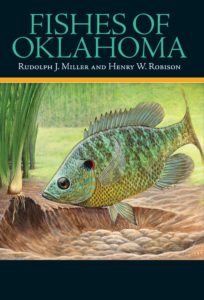 In 1962, Oklahoma State University offered Dr. Miller a temporary position without an interview. He took the job and never left, staying on to teach ethology, vertebrate natural history, and ichthyology, until he retired in 1990. During those years he had 8-10 graduate students every year, published about 100 papers on his research on fish behavior, and with one of his graduate students (Henry W. Robison) wrote and published two editions of the book, The Fishes of Oklahoma. The second edition was illustrated with 65 of his paintings (including the cover, shown here).
In 1962, Oklahoma State University offered Dr. Miller a temporary position without an interview. He took the job and never left, staying on to teach ethology, vertebrate natural history, and ichthyology, until he retired in 1990. During those years he had 8-10 graduate students every year, published about 100 papers on his research on fish behavior, and with one of his graduate students (Henry W. Robison) wrote and published two editions of the book, The Fishes of Oklahoma. The second edition was illustrated with 65 of his paintings (including the cover, shown here).
When Dr. Miller retired, art became his full-time career. He painted wildlife and landscapes. His home became a gallery with more than 130 of his paintings on display. For many years he had galleries selling his work in Jackson, Wyoming; Dallas, Vermont, Maryland, Oklahoma City, Tulsa, Chicago, and Multi- Arts in Stillwater, where he taught painting for many years.
One fish species is named for Dr. Miller. In 1991, Steven M. Norris and Michael E. Douglas described Ctenopoma (now Microctenopoma) milleri, a small (~45 mm) anabantid from the Democratic Republic of Congo. “It is our pleasure,” the authors wrote, “to name this attractive little fish for Rudolph J. Miller, who has long been involved in the study of anabantoid fish behavior and evolution.”
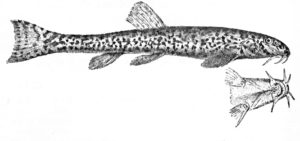
Triplophysa stolickai. From: Day, F. 1889. Fishes. In: W. T. Blanford (ed.) The Fauna of British India, including Ceylon and Burma. Taylor & Francis, London. v. 1: i-xviii + 1-548.
13 December 2017
Triplophysa stolickai — the highest-living fish?
Last week, we talked about a new species of snailfish (Liparidae) that, at 8178 below sea level, may be the deepest-living fish in the world. What’s the world’s highest-living fish? That record appears to belong to the Tibetan Stone Loach, Triplophysa stolickai, an abundant and very widely distributed nemacheilid loach that occurs in mountain streams and springs in Iran, Pakistan, India, Bhutan, China, and Tibet.
Austrian ichthyologist Franz Steindachner described the species as Cobitis stoličkai in 1866 from specimens collected from streams in the Tsumureri Lake system of western Tibet, at 4740 m. In 1980, Chinese scientists reported the loach from Tibetan hot springs near Lungmu Lake at 5200 m, the highest-known altitude of any fish.
That’s 13,378 m (8.3 miles) separating the deepest- and highest-living species of fish.
Steindachner named the loach in honor of paleontologist Ferdinand Stoliczka (1838-1874), who collected the type. His orthography has caused some confusion over the years. Note that Steindachner used a caron in his spelling the name (stoličkai), representing the “cz” sound as “čk.” But Article 32.5.2.1 of the International Code of Zoological Nomenclature prohibits the use of diacritical marks, in which case the diacritical mark is simply deleted from the spelling. Subsequent authors have attempted to “correct” the spelling by adding a “z” (stoliczkai), but Steindachner’s original spelling, minus the caron, is retained.
Steindachner placed the species in the catch-all loach genus Cobitis. It is now placed in Triplophysa, coined by Swedish zoologist and artist Hialmar Rendahl (1891-1969) in 1933. The name translates as triplos, thrice and physa, bladder, referring to how swim bladder of T. hutjertjuensis appears to consist of three parts, a “bony encapsulated diverticulum” and “two elongated bubbles” (translations).
6 December 2017
Pseudoliparis swirei — the deepest-living fish?
Deep-sea fishes fascinate us. But hadal fishes — named for the Greek netherworld Hades — blow us away. These are the fishes that live in the deepest part of the marine world, the ocean trenches, 6000 meters and beyond.
Last week, Zootaxa published the description of a new snailfish species that many news outlets are hailing as the deepest-living fish. But before we rewrite the record book, that claim comes with an asterisk.
The new species, Pseudoliparis swirei Gerringer & Linley 2017, is described from 37 individuals collected in the Pacific Ocean’s Mariana Trench at depths of 6898–7966 m. “These specimens are probably the deepest collected fish from the ocean bottom,” the authors carefully say, “with corroborating depth data.” The key phrases here are “collected fish from the ocean bottom” and “corroborating depth data.” Since then, a research team from Japan has recorded footage of the fish swimming at depths of 8178 meters.
In 1970, Abyssobrotula galathea (Nielsen 1977) was collected at 8370 m in the Puerto Rico Trench, in the northwestern Atlantic Ocean. That’s deeper than the recorded depth of snailfishes to date. But that specimen was obtained using a non-closing trawl net, so it’s impossible to ascertain its precise depth with confidence. In other words, perhaps the fish was caught before the trawl reached 8370 m, or while the trawl was being pulled in.
Pseudoliparis swirei has a name befitting its status as one of the world’s deepest — if not the deepest — living vertebrates. The Mariana Trench is home to the ocean’s deepest point, Challenger Deep, which is named for the HMS Challenger expedition that discovered the Mariana Trench in 1875. Their deepest sounding of 8184 m, then the greatest known ocean depth, was called Swire Deep after Herbert Swire (1851-1934), the ship’s First Navigating Sublieutenant. The authors named this fish in his honor, “in acknowledgment and gratitude of the crew members that have supported oceanographic research throughout history.”
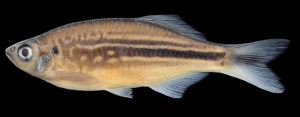
Devario coxi, holotype, adult male. From: Kullander, S.O., Rahman, M., Norén, M. & Mollah, A.R. (2017). Devario in Bangladesh: Species diversity, sibling species, and introgression within danionin cyprinids (Teleostei: Cyprinidae: Danioninae). PLoS ONE, 12 (11): e0186895.
29 November 2017
Devario coxi Kullander, Rahman, Norén & Mollah 2017
The name of this newly described cyprinid from Bangladesh has three etymologies.
1) It’s named after Cox’s Bazar, a town in Bangladesh, about 10 km north of the type locality, a small stream. Cox’s Bazar is one of the most-visited tourist destinations in Bangladesh. Its sandy beach, an unbroken 120 km (75 mi), is the second longest beach in the world.
2) It’s named in honor of Hiram Cox (1760-1799), the British diplomat and Army officer for whom Cox’s Bazar was named. According to Wikipedia, Cox sought to rehabilitate refugees in the area but died before he could finish his work. To commemorate his efforts, a market was established and named Cox’s Bazar in his honor.
3) Its name refers to the gene fragment — cytochrome c oxidase subunit 1, often shortened to COXI — used to help distinguish this species from its three congeners in Bangladesh.
As far as we know, it’s the first fish species named (at least in part) after a gene.
22 November 2017
Taeniamia ataenia

The unbanded T. ataenia on the left, the banded T. zosterophora on the right. Both photos from Randall, J. E. and U. Satapoomin. 1999. Archamia ataenia, a new species of cardinalfish (Perciformes: Apogonidae) from the Andaman Sea and Mentawai Islands. Phuket Marine Biological Center Research Bulletin No. 62: 1-8.
Here’s an unusual instance of a fish whose generic and specific names contradict each other.
In 1999, John E. Randall and Ukkrit Satapoomin described a new cardinalfish from the Eastern Indian Ocean, Archamia ataenia. The specific epithet means a-, without, and taenia, ribbon or band, referring to the absence of broad black bar as seen on the closely related A. zosterophora.
In 2013, cardinalfish taxonomist Thomas H. Fraser restricted Archamia to a single species, moving A. ataenia and A. zosterophora to a new genus he called Taeniamia. The –amia part of the name derives from Amia, a nonbinominal name applied to cardinalfishes by Gronow in 1763. The name is now used for the Bowfin (Amia calva) of North America, a very different kind of fish, but cardinalfish taxonomists continue to used it as a suffix in many cardinalfish genera.
The first part of Taeniamia, just like the second part of ataenia, derives from taenia, ribbon or band. According to Fraser, it refers to the “vertical wide bars and near vertical to curved narrow bars as lines on most of the species in this genus.” The key word here is “most,” since Archamia (now Taeniamia) ataenia does not have these bars.
It is, according to its scientific name, the Non-banded Banded Cardinalfish!
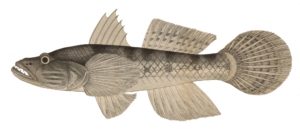
Glossogobius giurus. From: Hamilton, F. 1822. An account of the fishes found in the river Ganges and its branches. Edinburgh & London. i-vii + 1-405, Pls. 1-39.
15 November 2017
Butis and Giuris
As we delve deeper into the etymologies of the diverse goby order Gobiiformes (2500+ names), we’ve uncovered new information that clarifies the meaning of two goby names, Butis butis (Hamilton 1822) and the genus Giurus Sauvage 1880, as reported in the first of seven projected installments on goby name etymologies (posted 7 October 2017).
Here’s we said about Butis:
etymology not explained; according to Gill & Hoese (2011), possibly derived from the Indian word buti, a decorative, circular design woven, embroidered or printed on cloth, particularly common in sari fabric, that usually contrasts vividly with the background fabric (e.g., orange, gold, yellow, red or white over a dark field color), an interpretation in keeping with Hamilton’s description of its live coloration: “[it] is of a blackish colour, with the hinder fins spotted with red, and ventrals with black. There are two red spots at the roots of the pectoral fins.”
And here’s what we said about Giuris:
etymology not explained, perhaps alluding to Glossogobius giuris (Hamilton 1822), a gobiid (Gobiidae) from the Ganges River (possibly derived from a local Indian name)
Note that both names are connected to Francis Hamilton (1762-1829), a Scottish physician and naturalist who published an influential account of Indo-Gangetic fishes in 1822. He often used local Indian names for the Latin names of the fishes he described. Sometimes he explicitly made clear the connection between the local and Latin names. Sometimes he did not. Both “butis” and “giurus” are examples of the latter.
What follows is an example of the kind of research we do in uncovering fish-name etymologies, and why it’s important to track down every lead, no matter how insignificant it may seem.
While perusing Edward O. Murdy’s 1989 revision of the goby subfamily Oxudercinae (now a full family) — A taxonomic revision and cladistic analysis of the oxudercine gobies (Gobiidae: Oxudercinae). Records of the Australian Museum Suppl. No. 11: 1-93 — we noticed several citations to a 1934 paper by Indian ichthyologist Sunder Lal Hora (1896-1955) we had not seen: The systematic position of Hamilton’s species of gobioid fishes from the Ganges. Records of the Indian Museum, Calcutta 36: 483-490. We checked it out, hoping it might provide clues to the meanings of some of Hamilton’s local Indian names. Sure enough, it did.
Hora had access to Hamilton’s unpublished notes, which contained etymological bits and pieces that he did not include in his 1822 book. Hora cited these notes in his paper. “Butis” is derived from “Bhutī bēlē,” the local Indian name for this goby near Calcutta. “Giurus” is a latinization of “ghiyuri,” one of this goby’s local Gangetic names.
Now we have confirmation of what we suspected — that these Indian-sounding goby names are indeed Indian. Whether “Bhutī bēlē” is derived from the name of a colorful sari fabric remains to be seen. We assume Hamilton simply recorded local Indian fish names without knowing or investigating the meanings (if any) behind them.
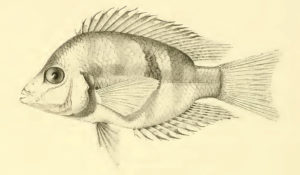
Thorichthys helleri, as illustrated in its original description: Steindachner, F. 1864. Beiträge zur Kenntniss der Chromiden Mejico’s und Central-Amerika’s. Denkschriften der Kaiserlichen Akademie der Wissenschaften in Wien, Mathematisch-Naturwissenschaftliche Classe. v. 23: 57-74, Pls. 1-5.
8 November 2017
Thorichthys Meek 1904
With the movie Thor: Ragnarok currently #1 at the box office, it got us wondering: Is the Mexican and Central American cichlid genus Thorichthys named for the Norse god of Thunder (the inspiration for the Marvel Comics character)? The answer is no. The author, American ichthyologist Seth Eugene Meek, was quite clear in explaining what the name means and why he coined it. But one cichlid expert cautions that Meek’s explanation may not accurately reflect the fish and suggests an intriguing parallel etymology.
Meek said that he named Thorichthys after the Greek throsko, meaning to leap, and ichthys, fish. In his account of T. helleri, Meek wrote:
These little fishes are exceedingly numerous in small isolated ponds, especially where there is a considerable amount of vegetation. They are attracted by anything which enters the water and will jump out of it in an apparently playful mood. When abundant they are easily caught in the hand, for as soon as your finger touches the water, they will come leaping towards you.
Cichlid aquarist Juan Miguel Artigas-Azas has probably spent more time observing and studying Mexican and Central American cichlids in their natural habitats than anyone. As creator and editor of the Cichlid Room Companion, his credentials are impeccable. He knows his stuff. So we should listen when he says that in the many occasions he has seen T. helleri in the wild, he has never seen them leap. In a 1995 article, now posted online, Artigas-Azas wrote, “Meek’s account must have had more to do with hungry isolated fish, probably in a small pool after the rainy season, than with a joyful attitude on the fish[s’] part.”
Artigas-Azas went on to explain that Thorichthys are called “Toritos” by locals, a Spanish word meaning “little bulls,” referring to typical cichlid behavior of mated pairs threatening nearby conspecifics by flaring their gills and lunging forward. Notice how close Toritos is to Thorichthys, even closer than throsko.
Meek’s explanation is the only one that matters, of course. He coined the name. He told us why. There’s no changing that. Even if it requires a leap of faith to believe his account of fish playfully leaping into the hands of humans.
We plan on catching a matinee of Thor: Ragnarok on Friday.

Daniel M. Cohen at his desk at the Systematics Laboratory, National Marine Fisheries Service, shortly before 1982. Photo by Bruce B. Collette.
1 November 2017
Daniel M. Cohen (1930-2017)
The ETYFish Project honors more than the names of fishes, but also the men and women who name them. Last week we learned that one of the 20th century’s most-accomplished ichthyologists, Daniel M. Cohen, had died. We do not know the details of his passing. When we tried to contact him earlier this year about a name he had coined, we learned that he was frail and would not be able to answer. He passed away September 27.
Born on 6 July 1930 in Chicago, Illinois, the future Dr. Cohen enjoyed biology and frequent trips to the Field Museum of Natural History. He also enjoyed sportfishing. He eventually made his way to Stanford University in California, earning a B. A. in biology in 1952. There Cohen met and collected fishes with fellow student James E. Böhlke, who named the first of 13 fishes in Cohen’s honor — the Eastern Pacific pikeblenny Chaenopsis coheni — in 1957. Cohen’s work as a curatorial assistant in the Stanford fish collection led to his doctoral work on deep-sea argentiniforms (marine smelts). Fifteen argentiniform names authored or co-authored by Dr. Cohen remain valid today.
In 1959, Dr. Cohen accepted a position as a systematic zoologist with the U.S. Bureau of Commercial Fisheries Ichthyological Laboratory at the U.S. National Museum in Washington, D.C. He stayed there for 23 years (see photo), becoming director of the newly formed National Systematics Laboratory in 1960. Here he began working on gadiform and ophidiiform fishes. In 1982, Dr. Cohen became Chief Curator of Life Sciences at the Los Museum of Natural History, where he continued his work on gadiforms and ophidiiforms (and from where he retired in 1995). By our count, Dr. Cohen authored or co-authored 18 taxa between these two orders that remain valid today.
In addition to Chaenopsis coheni mentioned above, here are the fish species named after Daniel M. Cohen, in chronological order:
- Glyptothorax coheni Ganguly, Datta & Sen 1972, a sisorid catfish from India, now considered a junior synonym of G. saisii (Jenkins 1910)
- Bassogigas coheni Mayer & Nalbant 1972, a cusk-eel from the Peru Trench of the eastern Pacific, now considered a junior synonym of Spectrunculus crassus (Vaillant 1888)
- Thalassenchelys coheni Castle & Raju 1975, recently discovered to be the larval form of the Bigmouth Conger Eel, Congriscus megastoma (Günther 1877)
- Liparis coheni Able 1976, a snailfish from the western North Atlantic
- Pelagocephalus coheni Tyler & Paxton 1979, a pufferfish from Norfolk Island in the South Pacific
- Glossanodon danieli Parin & Shcherbachev 1982, a herring smelt from the Nazca and Sala y Gómez Ridges of the southeastern Pacific
- Echiodon coheni Williams 1984, a pearlfish from the Indo-West Pacific
- Physiculus coheni Paulin 1989, a morid cod from off Christmas Island in the Indian Ocean
- Nezumia coheni Iwamoto & Merrett 1997, a grenadier or rattail from New Caledonia
- Gadella dancoheni Sazonov & Shcherbachev 2000, a morid cod from Yemen in the Arabian Sea
- Gunterichthys coheni Møller, Schwarzhans & Nielsen 2004, a viviparous brotula from the Pacific coast of Panama
- Luciobrotula coheni Nielsen 2009, a cusk-eel from the Gulf of Panama
All told, Dr. Cohen was the author or co-author of 124+ scientific publications. He is fondly remembered not just for the quality and significance of his work, but for his genuine concern and interest in the research, academic progress and careers of his many students over the years.
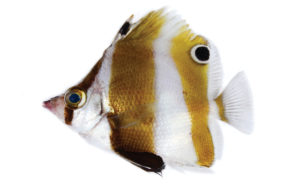
Roa rumsfeldi, holotype, shortly after death, 77.53 mm SL (photo L.A. Rocha).
25 October 2017
Roa rumsfeldi Rocha, Pinheiro, Wandell, Rocha & Shepherd 2017
When we received the description of this brand new species of butterflyfish (Chaetodontidae) last week, we thought: There’s no way this fish is named after Donald Rumsfeld, former Secretary of Defense under U.S. presidents Gerald Ford and George W. Bush and a key figure in the planning of the Afghanistan and Iraq wars.
We were wrong.
The first specimens were captured in 2015. Luiz A. Rocha and his team at the California Academy of Sciences assumed it was Roa modesta, a common species from Philippine waters. They placed their specimens in a jar for later study. Nearly two years later, they captured another specimen, which they brought back alive and placed on exhibit at the Academy’s Steinhart Aquarium. That’s when a sharp-eyed aquarist (co-author Matt Wandell) noted something fishy about the fish: Its dorsal fin spine was black, whereas it’s white on R. modesta. Rocha and team returned to the jar and realized they had a new species, confirmed by additional anatomical and genetic evidence.
The patronym doesn’t really honor Donald Rumsfeld so much as his famous quote. In 2002, when asked during a news briefing about the lack of evidence linking the government of Iraq with the supply of weapons of mass destruction to terrorist groups, Rumsfeld replied:
… there are known knowns; there are things we know we know. We also know there are known unknowns; that is to say we know there are some things we do not know. But there are also unknown unknowns – the ones we don’t know we don’t know.
According to the published description, Rumfeld’s quote about the “uncertainties of war” applies perfectly to the taxonomy of MCE (mesophotic coral ecosystem) species. “We only realized this species was new after we took a good look at it here at the aquarium in San Francisco,” the authors wrote, “so we think it’s a perfect example of an unknown unknown.”
An article in the San Francisco Chronicle provides a tad more clarity into this unusual patronymic choice. According to Rocha, fishes falls into three categories:
• “Known knowns” are newly discovered species that have already been classified.
• “Known unknowns” are species that are known to be new but have yet to be described
• “Unknown unknowns” are new species that haven’t described because taxonomists don’t know that they’re new, like R. rumsfeldi.
Although Rumsfeld popularized the phrase, he was not the first to utter “unknown unknowns.” Rumsfeld said he heard it from NASA administrator William Graham in the late 1990s. But the first known “unknown unknown” dates to the Johari window, a self-help technique created by two American psychologists in 1955.
As for the fish at the Steinhart Aquarium, it died just days after Rocha and his collaborators submitted their paper. It’s now in a jar on a shelf next to its cousins, unknown unknowns now known as Roa rumsfeldi.
Footnote: The generic name Roa has an interesting etymological history. Originally, David Starr Jordan (1921) proposed Loa as the name, the type having been based on a specimen killed by a lava stream from Mauna Loa in Hawaii. But he learned that Loa (meaning long or high) is preoccupied by Loa Stiles 1905, a genus of nematode (round) worms. So in 1923 he replaced it with Roa, a Polynesian (New Zealand, Tonga, Tahiti) word that also means long or high.
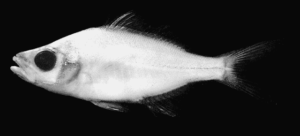
Holotype of Paradoxodacna piratica, 41.8 mm. From: Roberts, T. R. 1989. The freshwater fishes of western Borneo (Kalimantan Barat, Indonesia). Memoirs of the California Academy of Sciences No. 14: i-xii + 1-210.
18 October 2017
Paradoxodacna piratica Roberts 1989
Some fish names have vivid histories behind them. Some are etymologically complex or enigmatic. This name, however, is just plain cool. Say it out loud. Paradox-o-dak-na pi-ratica. Notice the rhythm and alliteration. Not just the initial “p” sounds but the internal “a” and “k” sounds as well. It’s something a poet might compose. And there’s lots of provocative meaning packed into its 21 letters and 10 syllables. A paradox? A pirate? It sounds like an unfriendly fish. And it is.
Tyson R. Roberts described Paradoxodacna piratica in his 1989 monograph on the freshwater fishes of Borneo. It’s a member of the Asiatic glassfish family Ambassidae, which contains several see-through fishes popular in the aquarium trade. But unlike its cousins, this glassfish doesn’t play well in the community tank. It’s lepidophagous. A scale eater. The piscine equivalent of a mugger or pickpocket. Its name reflects its nasty nature.
The generic name is derived from the Greek paradoxus, meaning strange or contrary to explanation, and danko, bite, referring to its highly modified dentition. The upper and lower jaws possess two rows of large conical teeth, the outer row with crowns labially (towards the mouth) directed, the inner row with crowns lingually (towards the tongue) directed. In addition, the upper jaw has a separate innermost row of very small lingually directed conical teeth, and the lower jaw has similar small teeth in anteriormost portion of inner tooth row. Perfect for eating scales (usually from cyprinids).
The specific name is from the Latin piratica, a sea-robber, referring to its scaly diet.
11 October 2017
Parahollardia schmidti Woods 1959
Loren P. Woods, Curator of Fishes at the Chicago Natural History Museum, described this spikefish (Tetraodontiformes: Triacanthodidae) from the Western Atlantic in 1959. The last sentence of his descriptions reads:
“This species is named in honor of Dr. Karl P. Schmidt.”
Woods did not provide any other information about Dr. Schmidt, nor why he honored him with this name. He didn’t need to. Because everybody in the American “ichths & herps” community knew “K-P” as one of the most important herpetologists of the 20th century. He was the Curator of Reptiles at the same museum (now the Field Museum of Natural History) where Woods worked. And everybody knew how he died.
In 1957, Marlin Perkins*, then the director of the Lincoln Park Zoo, had sent a living juvenile boomslang snake (Dispholidus typus) to Schmidt for identification. The snake bit Schmidt on the left thumb. Schmidt did not believe the bite was serious and did not seek medical aid. But being the ever-curious scientist, he documented the aftereffects for future publication, graphically detailing his symptoms by the hour as his condition grew dire. What Schmidt did not know is that the boomslang’s venom — deadlier than that of cobras, kraits and mambas — disables the blood-clotting process. He died 24 hours after the bite, from bleeding in his lungs, kidneys, heart, and brain.
Woods did not need to explain why he named this fish after Schmidt. Everybody knew and admired “K-P.” Everybody was shocked and saddened by his death. Schmidt was herpetological editor of Copeia, the same journal in which the description of Parahollardia schmidti appeared. And the same journal that published his final, and tragic, contribution to herpetology.
*Perkins, some of you might remember, hosted the famous Mutual of Omaha’s Wild Kingdom television series from 1963 to 1985.
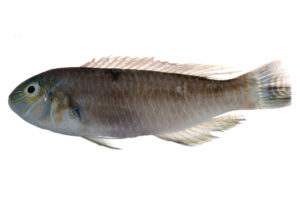
Choerodon typus, from Sorsogon Public Market, Luzon, Philippines. Source: Jeffrey T. Williams / Smithsonian Institution, National Museum of Natural History, Department of Vertebrate Zoology, Division of Fishes.
4 October 2017
Choerodon typus (Bleeker 1856)
Dutch medical doctor and ichthyologist Pieter Bleeker bestowed 23 new fish species the name “typus.” Bleeker did not explicitly state why he selected this name, but in all 23 instances the new species description accompanied a new genus description, with the new species serving as the type of the genus. It is therefore easy and reasonable to conclude that Bleeker named the new species named “typus” because that is what they are — type species. It’s a unimaginative name but it’s clear and utilitarian. Bleeker clearly liked calling type species “typus.”
Last month, Australian ichthyologist Martin F. Gomon published a revision of the Indo-West Pacific labrid genus Choerodon, also known as tuskfishes, with the descriptions of three new species. It’s a superb paperand we were delighted to see that Dr. Gomon included an etymology for each of the 26 recognized species. However, given Bleeker’s penchant for naming type species “typus,” we were surprised to see this etymological explanation for the Bluetooth Tuskfish, Choerodon typus (Bleeker 1856) from the north-eastern Indian Ocean and western Pacific from China to north-eastern Australia:
The name typus is from the Greek typos for “figure or mark”, most likely a reference to the black band dorsally on the side below the central dorsal fin spines.
Bleeker had originally named the species Xiphocheilus typus, representing both a new genus and species with X. typus clearly serving as the type. Although Xiphocheilus is now considered a synonym of Choerodon, that does not change the original intent or meaning of Bleeker’s name.
We asked Dr. Gomon about this via email. He very kindly replied that yes, our interpretation may be correct. But he added that since Bleeker did not provide a rationale for the name, and since the word “typus” has multiple meanings, his (Gomon’s) etymological interpretation cannot be ruled out.
Dr. Gomon is entirely correct, of course. But given Bleeker’s propensity for using “typus” for type species, that explanation should have been included.
What do you think?
27 September 2017
Trimma dalerocheila Winterbottom 1984

Left: Holly Arnold, undated photo. Right: Trimma dalerocheila, photo by Dr. Richard Winterbottom.
Sometimes a name leads you to unexpected places and fascinating people. The name of this goby from the Chagos Archipelago in the central Indian Ocean led us to Scotland and the Loch Ness Monster and to a beautiful, enigmatic woman named Holly Arnold.
Goby expert Richard Winterbottom (Royal Ontario Museum) named this goby in 1984. Here is the etymology he provided:
From the Greek ‘daleros,’ hot or fiery, and ‘cheilos,’ a lip, in allusion to the fiery red snout and lips of this species. The analogy was more firmly established by one of the co-collectors of the new species, Ms. Holly Arnold, who was the recipient of the scarcely appropriate nickname in a male-dominated Chagos society.
In an email, Dr. Winterbottom confirmed that the “scarcely appropriate nickname” was “Hot Lips.” He described Ms. Arnold as a beautiful (“both as a person and physically”) young American lady who, he remembered, worked for an organization attempting to prove the existence of the Loch Ness Monster. She was one of three women and about 22 men participating in the Chagos expedition. Many of the expedition members were from the British Armed Forces, some of whom referred to Ms. Arnold as “Holly Hot Lips.” The year was 1979, when sexual harassment was tolerated more than it is today.
Intrigued, we researched Holly Arnold on the web. She is mentioned in one other scientific publication that came from the Chagos expedition. And she was indeed an active researcher and proponent if the existence of the Loch Ness Monster in the 1970s. In fact, she worked at — and perhaps co-owned — a small curio shop near the lake that sold Nessie souvenirs. We found the photo shown here. And that is all we know about Ms. Holly Arnold.
Did she marry and change her name? Is she still alive?
Does she even know a beautiful goby is, sort of, named after her?
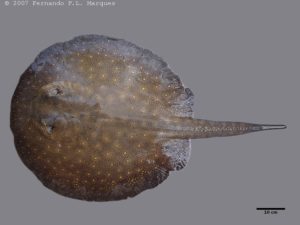
Potamotrygon adamastor. © 2007 Fernando P.L. Marques. Courtesy: João Pedro Fontanelle. Twitter @jpf_ishe
20 September 2017
Potamotrygon adamastor and Potamotrygon amazona
Three new species of freshwater stingray have recently been described from Brazil.
While the authors provided etymologies, we felt that explanations for two of the names didn’t go far enough. In other words, the authors explained what the names meant, but not how the names applied. So we contacted the senior author, João Pedro Fontanelle, who quickly provided the information we sought.
Potamotrygon adamastor is currently known only from rio Urariquera, a large right-bank tributary of rio Branco, Amazon Basin, state of Roraima, Brazil. It is named after Adamastor, one of the giants of Greek mythology who opposed Zeus and Thetis and was thereby sent to Earth, acting as a raging storm over the Cape of Storms. The epithet “adamastor” is an adaptation of the Greek “Adamastos,” meaning untamed. But what precisely is “untamed” about this ray?
According to Fontanelle, Adamastor is featured by Luis de Camões, a very famous Portuguese poet, in his work “Os Lusíadas.” The giant is depicted as violent, strong and fierce, both in “Os Lusiadas” and in Greek mythology. The name was chosen for this stingray because it is a very strong and violent fish, with a stinger that can pierce plastic boxes when caught.
Potamotrygon amazona is described primarily from the rio Jutaí basin, state of Amazonas, Brazil. It is named after the female warriors of Greek mythology, the Amazons, daughters of the god of war and goddess of harmony. One could guess that the name simply refers to its distribution. But according to Fontanelle, the name has a deeper meaning. Like P. adamastor, this stingray is very strong and muscular, but it has more denticles over its disc. These denticles reminded the authors of armor.
13 September 2017
The return of Typhlias Hubbs 1938
So far our etymological research has led to a change in authorship for three names and corrections to the spellings of several others. Recently we uncovered information that actually changes a name. Yesterday, our findings were published in the journal Zootaxa.
In 1938, American ichthyologist Carl Hubbs described Typhlias pearsei, representing both a new genus and species of blind cusk-eel (Ophidiiformes: Dinematichthyidae) from freshwater caves and sinkholes of the Yucatán peninsula of Mexico. Typhlias is derived from typhlos, blind, referring to its total lack of eyes. The specific name honors animal ecologist Arthur Sperry Pearse (1877-1956), who collected the type.
In 1951, Australian ichthyologist Gilbert P. Whitley proposed Typhliasina as a replacement name for Typhlias, believing it was preoccupied by a genus of rotifer with the same name described by Bryce, a microbiologist, in 1910. Virtually every ichthyological work covering cusk-eels and the fishes of Mexico published ever since Gilbert’s proposal have accepted Typhliasina as the cusk-eel’s generic name.
Whitley was fond of discovering and exposing homonyms — identical names proposed for different genera and species. Per the rules of nomenclature, the older homonym is retained and the newer one is replaced. Trouble is, Whitley replaced names even when they weren’t strictly homonyms. For example, he proposed replacing Lophiogobius Günther 1873 because he believed it was preoccupied by Lophogobius Gill 1862. The names are close — just one letter off — but they’re not homonyms. Whitley, apparently with good intentions, made this mistake many times.
We wondered if Whitley made the same mistake with Typhlias, and the answer is —no. Long story short, there is no rotiferan genus called Typhlias Bryce 1910. The name, as it appeared in Bryce’s paper, was merely a lapsus — an unintentional misspelling or misprinting — of Typhlina, proposed by Ehrenberg in 1828.
Since Typhlias 1910 is not an available name, it cannot be a senior homonym of Typhlias 1938. Therefore, Typhliasina Whitley 1951 is an unneeded replacement, and the generic name of this unique blind, cave-dwelling cusk-eel should return to the one it was originally given in 1938.
 6 September 2017
6 September 2017
Glossamia narindica Roberts 1978
The Slender Mouth Almighty is a freshwater cardinalfish (Apogonidae) that occurs in the Bensbach and middle Fly rivers of Papua New Guinea. Tyson R. Roberts described the species in 1978, but he did not provide an etymology. No problem. “-ica” usually means “belonging to,” in which case “Narind” may be the name of a person or a geographic name associated with the type locality. We searched and found nothing.
Fortunately, Dr. Roberts is still active and wasn’t in the field when we emailed him (he is known to drop off the grid for months at a time). Turns out, the etymology of narindica is something we never would have figured out on our own.
The first part of the name, “nar”, means nare, or nostril. The second part, “indica,” refers to India ink. Together, the two parts of the name refer to a key diagnostic character that distinguishes the species from the closely related G. aprion: Its snout features a large, well-defined, intensely black spot immediately ventrolateral to the posterior nostril. The black spot reminded Dr. Roberts of a blotch of India ink.
The etymology of Glossamia was easier to figure out. Coined by Theodore Gill in 1863, “glossa” means tongue and refers to a small patch of teeth on the tongue of G. aprion. “Amia” is an ancient Greek word for fish that Gronow applied in a nonbinominal way to cardinalfishes in 1763. It’s now considered a synonym of Apogon Lacepède 1801, but many cardinalfish taxonomists still use it as a general suffix for the family (Archamia, Cercamia, Fibramia, Lepidamia, Neamia, Nectamia, Rhabdamia, Siphamia, Sphaeramia, Taeniamia, Xeniamia, Zoramia).
Amia, of course, is still a valid name, but for an entirely different kind of fish — the Bowfin of eastern North America, Amia calva.

Rita P. Arthur (1932-2017).
30 August 2017
Rita rita (Hamilton 1822)
This week’s NOTW is a memorial to my beloved aunt, Rita P. Arthur, who passed away on 10 August 2017, a month shy of her 85th birthday.
Scottish physician and naturalist Francis Hamilton-Buchanan (1762-1829) described this southern Asian catfish as Pimelodus rita in 1822 from the estuaries of India. He retained its local Bengali name, rita. When Bleeker proposed a new genus for the species in 1853, he retained the local name also but, reflecting the fashion of the day, proposed a new name, Rita buchanani, after its original describer, to avoid the tautonymous Rita rita. There is nothing in the Code to prevent tautonyms, so Rita rita, the type genus and species of the family Ritidae, continues to be its name.
Aunt Rita’s name, just to be clear, has nothing to do with the catfish, or with India. I don’t know why she was given the name. Since she was born and raised a Catholic, I suspect she was named for Saint Rita of Cascia (1381-1457).
Rita loved animals, polkas, bowling, and scary movies. My fondest memory of her is when my brother and I talked her into joining us at a midnight showing of George A. Romero’s Dawn of the Dead when it first came out in 1978. She loved it.
Rest in peace, Auntie. Say hi to mom for me.

“Der Banjos” — the 1814 illustration on which the name Banjos banjos is based.
23 August 2017
Banjos banjos (Richardson 1846)
“Does ETYFIsh take requests?”
So asked John P. Sullivan, curator of fish taxonomy at NCBI/GenBank. He’s a big fan of bluegrass music and was curious if the Banjofish (Pempheriformes: Banjosidae), native to coastal waters of the western Pacific Ocean from Japan to the South China Sea, is connected to the banjo, an American musical instrument frequently associated with country, folk and bluegrass music.
According to Wikipedia, written references to the banjo in North America appear in the 18th century, and the instrument became increasingly available commercially from around the second quarter of the 19th century. So its use in an 19th-century fish name is not out of the question. The etymology of the word banjo is uncertain. Wikipedia lists five possible explanations:
- from the Yoruba word Bami jo, meaning “dance for me.”
- the Kimbundu word mbanza
- a dialectal pronunciation of the Portuguese bandore
- an early anglicisation of the Spanish bandurria
- a West African term for a bamboo stick formerly used for the instrument’s neck
Unfortunately, for bluegrass fans, the name of the fish has nothing to with the instrument. Surgeon-naturalist John Richardson (1787-1865) described the species as Anoplus banjos in 1846. He did not explain the name, but he indicated that the name dates to “Der Banjos,” from a plate (shown here) in Atlas zur Reise um die Welt unternommen auf Befehl seiner Kaiserlichen Majestat Alexander des Ersten auf den Schiffen ‘Nadeshda’ und ‘Newa’ unter dem Commando des Capitains von Krusenstern (1814). Krusenstern was Adam Johann Ritter von Krusenstern (1770-1846), a Russian admiral and explorer of Baltic German descent, who led the first Russian circumnavigation of the globe.
Apparently, banjos is the Japanese name for this fish, or at least was the name used in the early 19th-century. As best as I can tell, Krusenstern did not mention why the fish was given this name, although he used the word banjos (a Japanese magistrate) many times in his memoir.
Jordan & Thompson, in their 1912 review of perch-like fishes found in the waters of Japan, report that the name is derived from banzai, the traditional Japanese exclamation meaning “ten thousand years” of long life. No source is cited for this explanation, but Jordan worked closely with Japanese ichthyologists so I assume he got the explanation from them.
In 1925, Jordan & Hubbs report that the Japanese vernacular name for this species is Banzai-dai, which translates as the Hurrah Porgy.
In 1876, Bleeker proposed a new genus for the species, creating the tautonym Banjos banjos. Although it has nothing to do with the instrument, it’s a playful name, evoking the Steve Martin comedy bit and the Willie Nelson song about it being impossible to play a sad song on the banjo.
16 August 2017
The mysterious “muckfish” now has a name
In 2002, at the NANFA Convention in Ann Arbor, Michigan, Brazilian ichthyologist Paulo Petry showed me photos of the “muckfish,” a recently discovered fish from deep within the leaf litter of a Brazilian rainforest stream.
“I have no idea what it is,” he said. No one did. Its existence was baffling.
Maybe it’s a catfish. Maybe it’s related to the similar-looking (and ecologically convergence) Salamander Fish Lepidogalaxias salamandroides, of Australia. Or maybe it’s something entirely new and different, not just a new species, but a new family or even order. The only specimen was in poor condition. More were needed to figure out what the heck it is. Only then would it be given a name.
Years passed and I heard nothing more about this curious creature. The only information I found was this 2006 video from the Miami Museum and Science Center …
… featuring Dr. Petry searching for the fish. A brief glimpse of a living specimen in an aquarium is shown at the end.
Other than this video, the Internet was eerily quiet about the fish. Surely there had to be more photos, videos and guesses as to what it is. But I found nothing.
Late last week I was surprised and delighted to find in my in-box a PDF of an upcoming paper from the Zoological Journal of the Linnean Society.
Dr. Petry is one of the authors. At last, after 18 years, the mysterious “muckfish” has both a name and a hypothesized branch on the evolutionary Tree of Life.
Named Tarumania walkerae, and representing the only member of a new family, Tarumaniidae, the “muckfish” displays a set of unique characteristics that sets it apart from all other known bony fishes, either in South America or elsewhere. These include:
- reverse-imbricated scales on the head
- 244 or more scales along the midlateral lateral series
- an 11-chambered swimbladder extending along most of its body
- an anteriorly deflectable pelvic fin
- a platybasic (with widely separated trabeculae) skull
Although its shape gives little hint of its phylogenetic placement, its internal anatomy reveals that it belongs in the order Characiformes, where it is presumed to be a sister group to the Trahiras (Erythrinidae). It is the only known characiform with an anguilliform body shape and fossorial (burying) habits. In fact, all known specimens were collected deeply buried in massive leaf-litter deposits found in temporary pools during the low-water period. Its whereabouts during the flood season are yet unknown. It is a carnivore, preying on invertebrates.
The familial and generic names are derived from the name of the Taruma-Mirim, a tributary of the lower Rio Negro, and where the first specimen was collected. The specific name honors limnologist Ilse Walker, Instituto Nacional de Pesquisas da Amazônia (INPA), for her lifelong contribution to the knowledge of Amazonian ecology and for having collected the first (and for some years, only) known specimen in 1999.
The authors did not propose a common name. The ETYFish Project suggests that we continue calling it what fish enthusiasts have affectionately called it all this time. Muckfish.
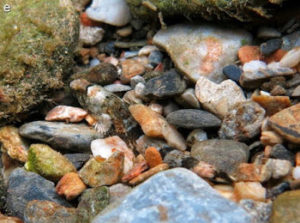
See the ninja? Photo from: Maeda, K., T. Saeki, C. Shinzato, R. Koyanagi and N. Satoh. 2017. Review of Schismatogobius (Gobiidae) from Japan, with the description of a new species. Ichthyological Research. Published online 25 July 2017.
9 August 2017
Schismatogobius ninja Maeda, Saeki & Satoh 2017
Ninjas seem to be popular with modern-day ichthyologists. There’s the Ninja Lanternshark, Etmopterus benchleyi, described in 2015. And now there’s Schismatogobius ninja, a new species of goby from fast-flowing freshwater streams in the northern part of Okinawa Island, Japan.
S. ninja is an attractively colored goby when viewed against a simple background, but it’s cryptically colored and difficult to see against the gravel substrates of its habitat. They usually stay on the bottom and often bury half of their body in the substratum. They are hard to detect if they remain motionless. This stealthy ability reminded the authors of the ‘‘ninja,” a covert agent or mercenary in feudal Japan, well known for being masters of camouflage.
Proposed by de Beaufort in 1912, the meaning of Schismatogobius is unclear. Gobius, of course, means goby. Schismato– is a prefix that confers a split, crack, fissure or separation. But there is nothing in de Beaufort’s description that indicates why he selected this prefix, nor can we find any attribute in modern-day accounts of the genus that could be described as split or separated. Perhaps de Beaufort was inferring that the scaleless body of the type species, S. bruynisi, separates it from other gobies of the Indo-Australian archipelago.
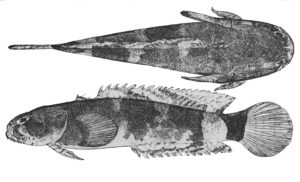
Chatrabus (originally Tharbacus) hendersoni from Smith, J. L. B. 1952. The fishes of the family Batrachoididae from South and East Africa. Annals and Magazine of Natural History (Series 12) v. 5 (no. 52) (art. 38): 313-339. Named in honor of David Henderson, a boy who found the type specimen “thrown up by a storm” at Algoa Bay, South Africa.
2 August 2017
Anagrammatic Toadfishes
South African ichthyologist J.L.B. Smith was often enigmatic with the names he coined. It seemed he took a puckish delight in coming up with names only he knew the meaning of. In 1949 and then again in 1952, he proposed a number of new genera of toadfishes (Batroichoididae) that appear to be derived from Latin words. But you won’t find these words in any Latin dictionary:
• Chatrabus Smith 1949
• Barchatus Smith 1952
• Sanopus Smith 1952
• Tharbacus Smith 1952
As far as we know, no one has heretofore explained the meaning of these names. I, too, was initially stumped, but the Scrabble® player in me saw a repeating pattern in the three of them. Barchatus is very similar to Batrachus Bloch & Schneider 1801, an early toadfish name derived from the Greek word meaning frog. Although Batrachus is now a junior synonym of Batrachoides (=toad-like) Lacepède 1800, it was still in use when Smith published his papers. With my pencil and a piece of scrap paper, I quickly worked out that Barchatus is an anagram of Batrachus. The same is true for Chatrabus and Tharbacus as well (note: the latter is now a junior synonym of the former).
Sanopus, of course, is not an anagram of Batrachus. But it is an anagram of Opsanus Rafinesque 1818, another toadfish genus and the original genus of the type species, S. barbatus
My guess is that Smith resorted to anagrams to suggest that these genera are all closely related. I wonder if he ever suspected that someone 65 years later would bother to figure them out.

Robert W. Shufeldt in 1893.
26 July 2017
Ctenogobius shufeldti (Jordan & Eigenmann 1887)
Adolf Hitler is probably the most despicable person ever to have an animal named after him: the blind cave beetle Anophthalmus hitleri. Who is the most despicable person honored in the name of a fish? We’re only halfway through the fishes, so we haven’t examined every eponym. But a finalist would have to be the American surgeon-zoologist Robert Wilson Shufeldt (1850-1934), who collected the holotype of Ctenogobius shufeldti, a euryhaline goby that occurs in the western Atlantic from the USA to Venezuela and Brazil.
Shufeldt was an Army physician who dabbled in natural history. He published on a wide range of natural history topics, including the anatomy and systematics of birds and the ecology of Anolis lizards, but it’s his extreme views on race and white supremacy for which he is most (but not fondly) remembered today.
Writing in two books — “The Negro: A Menace to American Civilization” (1907) and “America’s Problem: The Negro” (1915) — Shufeldt believed that blacks were less than human and therefore more ape-like than whites. This was not a radical concept at the time, but Shufeldt pushed these beliefs to a reprehensible extreme. He believed blacks and persons of mixed race were inherently evil, naturally criminal and sexually insatiable. They were driven by lust, never love, because love belongs to a “higher state of development.” When “libidinous substances flowing the blood stimulates [a black man] into sexual fury … nothing short of a bullet will stop him.”
Bullets, he argued, were justified. In “The Negro,” Shufeldt seemed to revel in the horrific details of the torturing and eventual burning to death of Henry Smith, a black teenager, in 1893. He said he disapproved of lynchings, but stated that the victims brought it upon themselves. By committing hideous sexual crimes, blacks were at fault for driving whites to behave in hideous ways. “It is the presence of the negro among us that is responsible for the lynch law,” he wrote, “and not the tastes of our people for such brutal horrors.”
Shufeldt did not argue for genocide. Instead, he recommended that the U.S. government “Force every loafing negro to work. Put him on Government roads — we need them. … Take him away from all cultural education. Make it a penal offense to sell or give him alcohol or drugs. Make him the nation’s ward, as are the self-respecting Indian …”. But a better alternative, Shufeldt said, was to send all black and mixed-race people back to Africa. The fact that blacks were not returning to Africa on their own accord after emancipation, he said, “is one of the best proofs in the world of the extremely low position they occupy in any sort of a classification of the genus Homo.”
Today, Shufeldt’s polemics have found a new audience online among racists and white supremacists, comprising — in the words of anthropologist Della Collins Cook — “a staple of on-the-web pornography of racial violence.”
It seems Shufeldt was despicable at home as well. His first wife committed suicide in an asylum (gee, wonder why). In 1895, he married Florence Audubon, granddaughter of the famous ornithologist. She left him after two months, claiming he was having an affair with their Norwegian housekeeper (who later became wife #3). In an attempt to humiliate and perhaps blackmail his wife, Shufeldt published a pamphlet called “On Female Impotency,” which is illustrated with photos of a nude woman many believe was Florence Audubon. In the article, Shufeldt claimed he was affiliated with the Smithsonian Institution. Presumably embarrassed by the article, the Smithsonian dismissed him in 1897.
The Smithsonian’s Department of Vertebrate Zoology, apparently oblivious to his views on race, inducted Shufeldt into its “hall of fame.”
19 July 2017
Leporinus enyae Burns, Chatfield, Birindelli & Sidlauskas 2017
This recently described anostomid (Characiformes) occurs in the Orinoco River drainage of Venezuela and Brazil. The authors named in honor of the Irish singer Enya (b. 1961), whose “beautiful song ‘Orinoco Flow’ celebrates the flow of the mighty Orinoco River, which the new species inhabits.”
A press release about the new species provided more background about the song’s influence on the team who described it.
“Whenever we were in the lab at Oregon State working on the fishes,” senior author Michael Burns said, “Ben Frable would always play ‘Orinoco Flow,’” referring to another graduate student in the lab.
“I heard the song so often in the lab it got stuck in my head,” co-author Marcus Chatfield said. “Then I just started listening to it on purpose when I was taking measurements of the specimens. When the time came around for choosing names, it just felt right to name this new beautiful fish from the Orinoco after the artist who wrote that beautiful song.”
“We’re also big fans of her music,” added co-author Brian Sidlauskas, the curator of fishes at Oregon State University as well as an amateur Celtic harper.
Funny thing is, the song really isn’t about the Orinoco River. Instead, it refers to Orinoco Studios, London, where the song and the rest of Enya’s 1988 Watermark album was recorded.
The words “We can steer, we can near, with Rob Dickins at the wheel” refer to Rob Dickins, the head of Enya’s record label WEA and producer on the album. Dickins semi-seriously pressured Enya to write a song catchy or tuneful enough to be a single. Enya and her manager/producer sent over what became “Orinoco Flow.”
“Orinoco was the name of the studio,” Dickins said, “and I think they saw me as the captain of the ship. The whole thing was a metaphor for a journey for all of us.”

Henry David Thoreau. 12 July 1817 – 6 May 1862.
12 July 2017
Semotilus thoreauianus Jordan 1877
Today, 12 July, marks the bicentennial of the birth of Henry David Thoreau, the American essayist, poet, philosopher, abolitionist, and naturalist. His writings have much to offer today’s world. He embraced civil rights. He triumphed individual conscience. And he loved nature. His best known work is Walden, about living the simple life surrounded by nature.
Fifteen years after Thoreau’s death in 1862, the dean of American ichthyology, David Starr Jordan, described a new species of cyprinid from the southeastern American states of Georgia, Florida and Alabama. “This species is named in honor of the late Henry David Thoreau, of Concord, Mass.,” Jordan wrote, “an excellent ichthyologist, one of the first to say a good word for the study of Cyprinidae.*”
The asterisk (*) refers to the “good word,” printed as a footnote. It’s a passage from Thoreau’s 1842 “Essay on the Natural History of Massachusetts,” and it’s our favorite fish quote of all time:
“I am the wiser in respect to all knowledge, and the better qualified for all fortunes, for knowing that there is a minnow in the brook. Methinks I have need even of his sympathy and to be his fellow in a degree.”

Grammonus ater. From: Risso, A. 1810. Ichthyologie de Nice, ou histoire naturelle des poissons du Département des Alpes Maritimes. F. Schoell, Paris. i-xxxvi + 1-388, Pls. 1-11.
5 July 2017
Grammonus ater (Risso 1810)
This fish is a viviparous (livebearing) brotula (Bythitidae) that occurs in the Mediterranean from the Balearic Islands to the Adriatic. Its specific name — ater, meaning black, referring to its ebony black (“noir d’ébène”) color on a background of purplish red — is not why we’re featuring it this week. Instead, we are amused by part of Risso’s description (here translated from the French), which judges the fish rather harshly in our opinion:
It differs from the dolphinfish genus, not only in the single ray of its jugular fins, but also in its morals, instinct, and habits. Foible and timid, it appears to be relegated all year long in obscure caves devoid of all vegetation. He never approaches the shore where its slow swimming cannot shield it from the voracity of moray eels and scorpionfish. It is towards the middle of August when the female lays beneath the rocks dark blue eggs intertwined with a whitish network, which hatch a short time later, and the small fish which come from it soon retire under rocks surrounded by muddy sediment, where they seem to be buried alive. The flesh of this species is soft, slobbery and tasteless.
Risso is correct in describing the fish’s cave habitat and late-summer breeding season. A shallow water species, Grammonus ater is nocturnal in habits, retreating to dim or lightless caves during the day. (Curious: How did Risso know this? This seems like information one can only make via underwater observations, and diving equipment was crude and not readily available in the early 19th century.)
Spawning does occur in August, but Risso is incorrect in saying that Grammonus ater lays eggs. Like other members of the family Bythtidae, it gives birth to live young.
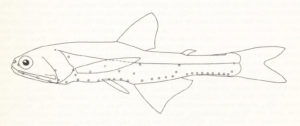
Lampanyctus steinbecki. From: Bolin, R. L. 1939. A review of the myctophid fishes of the Pacific coast of the United States and of Lower California. Stanford Ichthyological Bulletin v. 1 (no. 4): 89-156.
28 June 2017
Lampanyctus steinbecki Bolin 1939
Has an ichthyologist ever named a fish to honor someone and then later tried to retract it? According to Milton Love, a research biologist at the Marine Science Institute, University of California, Santa Barbara, the answer is yes.*
In the late 1930s, Rolf L. Bolin (1901-1973), an ichthyologist at Stanford University’s Hopkins Marine Station (Pacific Grove, California), became friends with American writer John Steinbeck (1902-1968). In addition to writing such classic American novels as Of Mice and Men and The Grapes of Wrath, Steinbeck was a serious amateur naturalist who enjoyed collecting and studying the aquatic life of Monterey Bay and the Gulf of California. Bolin is mentioned several times in Steinbeck’s non-fiction work, The Log from the Sea of Cortez (1951).
In 1939, Bolin described a new species of lanternfish (Myctophiformes: Myctophidae) from Santa Catalina Island, California. He named it Lampanyctus steinbecki, saying only “Named for my friend, Mr. John Steinbeck.”
According to Dr. Love, Steinbeck had given Bolin a signed first edition of one of his novels.
Touched by the gesture, Bolin named after Steinbeck in return. Soon after, Steinbeck asked for the book back (for unknown reasons) and never returned it.
“Later, in a moment of reflection,” wrote Love, “Bolin stated that he spent a great deal of time thereafter trying to synonymise L. steinbecki with any other species (thus invalidating the name).”
He did not succeed.
*Source: Milton Love, “A rose by any other name,” New Scientist, 13 May 1982, 431-432.
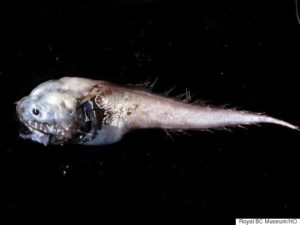
Acanthonus armatus. Courtesy: Royal BC Museum in Victoria.
21 June 2017
How the “Assfish” got its name
The internet is amused by the name of Bony-eared Assfish. Formally named Acanthonus armatus Günther 1878, this cusk-eel (Ophidiidae) occurs in tropical and subtropical seas worldwide. It has a big, bulbous head and flabby skin, which combine to make it a slow swimmer, presumably an energy-saving adaptation in the food-scarce habitat of the deep sea. It’s an ugly fish, to be sure, bestowed with an equally ugly common name. But of all the things it could be called, why “assfish”?
The answer lies in the generic name, coined by Günther when he described the species in 1878. The first part of name, acanthus, means spine and refers to the strong spines on the fish’s head and opercles. The second part of the name, onus, has two meanings: a hake or hake-like fish, and ass — not the gluteal ass, but the equine ass, as in horse or donkey. (The specific name “armatus” means armed, i.e., armed with strong spines.) Following a rather convoluted etymological path over the centuries, the two meanings are intertwined.
“Onus” is a latinization of the Greek “onos,” a name dating to Aristotle for a fish that hid in the substrate and used appendages inside its mouth to lure prey. Thanks to a recent and superb paper detailing Aristotle’s contributions to ichthyology and fish-name etymology, we can be fairly certain that the fish in question was the Mediterranean hake, Phycis blennoides (Gadidae).
In Greek, “onos,” also means ass or donkey. We have no idea why Aristotle applied that word to the hake. British naturalist Francis Day attempted an explanation in his 1882 book The Fishes of Great Britain and Ireland. The name, he suggested, referred either to the hake’s donkey-like color or to the fact that in ancient Greece hakes and other cod-like fishes were “carried to market on the backs of asses.” We find neither explanation convincing.
Whatever the explanation, the connection between “onos” and “hake” (or cod-like fish) stuck. In the 16th-century, Belon applied the name “gaiderapsaro” to a rockling, later named Gaidropsarus by Rafinesque 1810. (Gáidaros is the modern Greek equivalent of onos.) In 1827, Risso proposed the genus Onos, not realizing that Gaidropsarus was a senior synonym. Classical scholars misinterpreted Aristotle’s text and applied his “onos” to a different fish, the European hake, Merluccius merluccius (Merlucciidae).
Günther adopted “onos” as his go-to suffix for a hake-like fish. He used it several times: Melanonus, Lyconus, Macruronus, Aphyonus, Typhlonus and, of course, Acanthonus. Others followed suit: Barathronus and Bathyonus Goode & Bean 1885; Grammonus Gill 1896; Holcomycteronus, Pseudonus and Sciadonus Garman 1899. (It should be noted that 19th-century ichthyologists considered hakes and cods [Gadiformes] and cusk-eels and brotulas [Ophidiiformes] to be related.)
Whoever coined the common name “Bony-eared Assfish” simply translated Acanthonus, referring to the bony spine on the opercle and “onus,” meaning donkey or ass — apparently unaware that Günther (and others) used “onus” to mean hake.
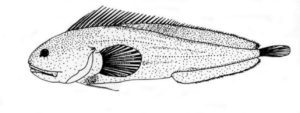
Brosmodorsalis persicinus from: Paulin, C. D. and C. D. Roberts. 1989. A new genus and species of bythitid fish (Teleostei: Ophidiiformes) from New Zealand. Journal of Natural History v. 23 (no. 2): 355-361.
14 June 2017
Our 20,000th name: Brosmodorsalis persicinus Paulin & Roberts 1989
This past Sunday, we recorded the 20,000th fish-name etymology, and it’s a “real peach” (American idiom for someone or something excellent).
Brosmodorsalis persicinus is a viviparous brotula that occurs in fairly shallow water (up to 17 m) off the northeast coast of the north island of New Zealand. Its specific name means “peach-like” (persica is Latin for peach) and refers to its pinkish or peach-like coloration in life. (Its common name is Pink Brotula.)
B. persicinus is the only species in its genus. The generic name — also proposed by Paulin & Roberts — is a two-part construction. The first part, Brosmo-, refers to its then-placement in the subfamily Brosmophycinae (now considered polyphyletic). The second part, dorsalis, referring to two dorsal-fin characters: origin well anterior to posterior margin of operculum, and anterior rays free of membrane
The 20,000 name total includes work on several orders not yet up on our website. These include Ophidiiformes (cusk-eels, almost done), Batrachoidiformes (toadfishes), Kurtiformes (a fairly new order, combining nursery fishes with cardinal fishes), and Gobiiformes (a mega-order, with ~2500 names to research).
With an estimated 35,000 valid species- and 5,000 valid genus-level names, 20,000 means we’re halfway done!
Our continued thanks to Ron Fricke, Erwin Schraml, Thomas O. Litz, Larry Page, Artem Prokofiev, Jan Jeffrey Hoover, Peter Unmack, Laura Wilson, and many others. Without your help and generosity, we’d probably still be at name 5,000.
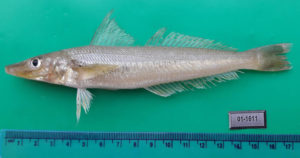
Holotype of Sillago panhwari, from: Panhwar, S. K., N. Farooq, N. Qamar, W. Shaikh and M. Mairaj 2017. A new Sillago species (family Sillaginidae) with description of six sillaginids from the northern Arabian Sea. Marine Biodiversity: [1-7]. [Published online.]
7 June 2017
Sillago panhwari Panhwar, Farooq, Qamar, Shaikh & Mairaj 2017
It’s considered poor etiquette to name a plant or animal after oneself, but that appears to be the case for this recently described sillago (Sillaginidae) from the northern Arabian Sea coast of Pakistan.
Sher Khan Panhwar (Center of Excellence in Marine Biology, University of Karachi) is the senior author of the paper in which the description appears. According to the awkwardly worded etymology section, “The species name panhwari was named by the Sher Khan Panhwar, who pioneered work on Pakistani sillaginid fishes.”
On 19 May 2017, we sent Dr. Panhwar an email asking if he named the fish after himself, or if one of his four co-authors suggested the honor. We have yet to receive a reply.
The etymology of Sillago is unclear. Cuvier did not explain the name when he proposed the genus in 1816, nor when he redescribed the genus in the third volume of Histoire naturelle des poisons in 1829. Wikipedia offers competing explanations for the name, both sourced to FishBase: a locality in Australia, possibly Sillago Reef off the coast of Queensland, and a derivation of the Greek term syllego, meaning “to meet.” We doubt the first explanation since Cuvier described Sillago acuta (now a junior synonym of S. sihama) from the Indian Ocean, whereas Sillago Reef is near Queensland on the Pacific side of Australia. (Maybe the reef was named after the fish?) As for the second explanation, we find nothing in Cuvier’s texts to support the notion that Sillago means “to meet.”
Here’s a third explanation. According to A Universal Etymological and Pronouncing Dictionary of the English Language (1848) — usually a reliable source — Sillago is derived from sillot, satire (and hence sharp), referring to its fins, and the Greek ago, meaning “I bear.” Is this explanation accurate? Partially, maybe. Cuvier did not mention sharp or thorny fins in his brief 1816 description, but he did mention that the opercula are each armed with a small spine (“leurs opercules armés d’une petite épine”). What’s more, he named his species acuta, which means sharp.
Our guess is that the Dictionary explanation is closer to the truth than the ones put forth by Wikipedia and FishBase.
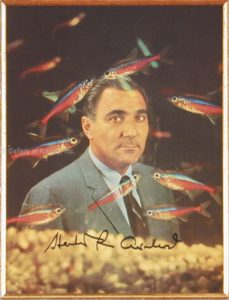 31 May 2017
31 May 2017
Paracheirodon axelrodi (Schultz 1956)
The recent death (15 May) of tropical-fish tycoon and pet-book publisher Herbert R. Axelrod brings to mind one of the most contentious battles in fish nomenclature — the naming of the Cardinal Tetra. The story has been told many times before, usually as an illustration of Axelrod’s larger-than-life ego and win-at-all-costs approach to business, life and even science. It’s a story worth telling again.
The Cardinal Tetra is the first of 18 or so fish species named after Axelrod. In most of these cases, he was given the honor because he funded the expeditions that collected the types, or otherwise donated money that made field work and/or publication possible. Early in his career, Axelrod sent specimens of unknown aquarium fishes to Leonard P. Schultz at the Smithsonian Institution. “Schultz offered to name a fish [after me] earlier,” Axelrod told master aquarist Rosario LaCorte, “but I will select the fish that I want when I see it.” That fish would be the strikingly beautiful Cardinal Tetra, which had just entered the aquarium hobby and which everyone knew would quickly become one of the most desired aquarium fishes ever.
Some of the first — if not the first — Cardinal Tetras to enter America came through Paramount Aquarium in Miami, Florida, co-owned by Ferdinand (Fred) Cochu. He sent specimens of this more brightly colored “Neon Tetra” to Alan Fletcher, editor of The Aquarium magazine, which was published by the legendary William T. Innes. Fletcher (or Innes) preserved a few specimens and sent them to ichthyologist George S. Myers at Stanford University.
Months went by and Fletcher heard nothing back from Myers. Word eventually got around that Axelrod received some Cardinal Tetras from The Fish Bowl, a tropical-fish store near his home in New Jersey. (Axelrod later claimed he discovered the Cardinal Tetra while searching for discus in the Rio Negro.) Now with a fish beautiful enough to bear his name, Axelrod jumped on a plane to Washington, D.C., and hand-delivered the specimens to Schultz. “This is the fish I want named after me,” he reportedly said.
Word got back to Cochu and Fletcher that Axelrod and Schultz were planning their own description. Fletcher called Myers and asked how the description was coming along. Myers apparently had forgotten about it, but agreed to work on it immediately. In truth, he probably passed the assignment to his graduate student, a young Stanley Weitzman.
Myers and Weitzman named the fish Hyphessobrycon cardinalis and published their description in the Stanford Ichthyological Bulletin v. 7 (no. 1): 1-4. The official publication date was 21 Feb. 1956. They selected the adjective cardinalis because of the brilliant red color on the sides, presumably reminiscent of the Cardinal Flower, Lobelia cardinalis, or the deep scarlet color of a Catholic cardinal’s cassock. This is the origin of the common name, Cardinal Tetra.
At the same time Myers and Weitzman completed their description, Schultz completed his, or at least a preliminary version of it. Schultz sent his description in the form of a personal letter to Axelrod, dated 15 Feb. 1956, which Axelrod reprinted in the March-April 1956 issue of his magazine Tropical Fish Hobbyist. Schultz called it Cheirodon axelrodi, the “Scarlet Characin,” naming it after Axelrod for sending specimens to Schultz for study and to the Smithsonian for their “permanent preservation.” The issue was dated 20 Feb. 1956, one day before the Myers & Weitzman description had appeared. Curiously, it was the only issue of Tropical Fish Hobbyist that was dated to the day, not just the month and year. (Rumor has it that Axelrod personally rushed to the Post Office with a hand-folded copy of the issue to validate the date.)
In May 1956, Leslie W. Ashdown, editor of the British magazine Water Life, petitioned the International Commission of Zoological Nomenclature (ICZN) to investigate the publications and rule which name had priority. “This fish is likely to become widely used by aquarists,” Ashdown wrote, “and it is important therefore that the scientific name to be used for it should be determined without delay.” Ashdown’s petition carefully avoided mentioning what many had suspected — that Axelrod backdated his publication.
The ICZN got on the case right away. Schultz testified via letter that Axelrod had mailed a “printed tear sheet” from the magazine on 18 Feb. 1956, which Schultz received two days later, 20 Feb. In addition, Axelrod had also sent Schultz a photocopied receipt from the U.S. Post Office indicating that the issue first mailed the same day (20 Feb.). Axelrod, also via letter, confirmed the dates, adding that some copies of the issue were distributed to local New Jersey pet shops on 17 Feb. and/or 18 Feb.
Axelrod provided more details in the next issue of his magazine. In fact, he more or less admitted that he rushed Schultz’ description into print. He first received the manuscript via special delivery on 16 Feb., had it typeset within three hours, and rushed it back to Schultz for proofreading. He received Schultz’ comments the next day. Since the issue was already on the press, corrections were made directly on the plate.
In her written testimony, Margaret H. Storey, Associate Editor of the Stanford Ichthyological Bulletin, confirmed that the description of Hyphessobrycon cardinalis was printed and first distributed on 21 Feb. 1956.
The ICZN ruled by a vote of 19-5 in favor of Schultz’ name. (One of the ICZN members who voted in favor of Schultz was none other than the legendary evolutionary biologist Ernst Mayr.) We do not know the reasons behind the five votes in favor of Myers & Weitzman. We do know, however, that one of the issues the ICZN considered was that H. cardinalis was clearly published as a voluntary act of publication by its authors in a journal normally serving as a vehicle of taxonomic publication, whereas C. axelrodi — based on a personal letter — was involuntarily published in a lay journal at the discretion and for the personal benefit of its publisher.
Some members of the voting panel reportedly later told Innes or Myers that the commission suspected that something shady had gone on, but that they couldn’t prove it. Based on the evidence at hand, Cheirodon axelrodi beat Hyphessobrycon cardinalis by one day.
According to Alan Fletcher, Fred Cochu “had gone to his grave resenting that ‘his’ fish was named for someone who had nothing to do with its discovery or introduction.” Many aquarists and ichthyologists to this day believe Axelrod got away with fudging the dates, a suspicion buttressed by his penchant for lies, tall tales, womanizing and future legal troubles (including 18 months in federal prison for tax fraud). Our hunch is that Axelrod did not backdate his publication (why would the reputable Schultz allow that?), but that he knew he was in a race and did everything he could to rush Schultz’ letter into print. If Myers had not delayed his description, or if Axelrod had gotten to the post office after it had closed, it’s very possible that the Cardinal Tetra would today have the name cardinalis.
 23 May 2017
23 May 2017
Happy birthday, Linnaeus!
We’re posting this week’s “Name of the Week” a day early to commemorate the 310th birthday of Carl von Linné (aka Carolus Linnaeus), the father of taxonomy. Depending on which calendar is used, Linnaeus was born on 13 May (Swedish), 12 May (Julian), or 23 May (Gregorian), in 1707.
Although a dozen or so animals (mostly insects) have been named after Linnaeus, he is not honored in the binomial of any currently valid fish taxon [see below], although a few scientists have tried:
In 1845, Charles Lucien Bonaparte proposed Carassius linnaei as a new name for the Crucian Carp, Cyprinus carassius Linnaeus 1758. Bonaparte did not indicate why he changed the name, but it looks like he sought to avoid “Strickland tautonymy.” Three years earlier, British ornithologist Hugh Edwin Strickland was tasked with codifying the rules of zoological nomenclature (a precursor to today’s ICZN). One such rule was to prohibit names in which the same word is used for both the genus and the species, known as tautonyms. To replace “Carassius carassius” when Cyprinus carassius was placed in Carassius, yet still wanting to honor the species’ original author, Bonaparte coined Carassius linnaei as a sort of compromise. Strickland’s rule against tautonyms has since been revoked, making C. linnaei an unneeded replacement name.
Strickland tautonymy was the reason for 24 name changes proposed by Swedish zoologist August Wilhelm Malm in 1877. Malm produced a catalog of Swedish fishes wherein he replaced every tautonymous name that dated to Linnaeus 1758 with a name that honored Linnaeus. The eel Anguilla anguilla became Anguilla linnei, the tench Tinca tinca became Tinca linnei, the burbot Lota lota become Lota linnei, and so on. These well-intentioned names have long been exiled to synonymy.
Tetragonopterus linnaei Valenciennes 1850 is the only fish taxon named after Linnaeus that is still technically available. Linnaeus had briefly described a similar fish when he cataloged the King of Sweden’s natural history cabinet in 1754. He named it Albula maculata. Four years later, Linnaeus dropped the name from the 10th edition of his Systema Naturae (the official starting point of zoological nomenclature), presumably because he now believed it was the same species as his Salmo bimaculatus. When Valenciennes described his specimen in 1850, he noted how much it resembled the illustration of Albula maculata published by Linnaeus in 1754, so he named it in honor of the man who had initially described it.
Tetragonopterus linnaei is now considered a junior synonym of Astyanax bimaculatus (Linnaeus 1758). Should a review of this wide-ranging characin (it occurs in Brazil, Bolivia, Colombia, Ecuador, French Guiana, Guyana, Panama, Peru, Suriname, Trinidad and Tobago and Venezuela) reveal hidden morphological and/or genetic diversity, it’s possible that Tetragonopterus linnaei could be resurrected (as “Astyanax linnaei”), which would make it the only valid fish species named after the father of naming species.
18 Jan. 2018 correction: Linnaeus is indeed honored in the name of a currently valid fish, the Lake Victoria cichlid Haplochromis vonlinnei van Oijen & de Zeeuw 2008, “named after the contriver of modern biological nomenclature Carl von Linné,” the occasion of the 250th anniversary of the official start of zoological nomenclature.
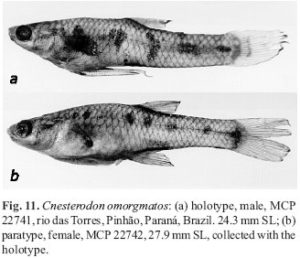
From: Lucinda, P. H. F. and J. C. Garavello. 2001. Two new species of Cnesterodon Garman, 1895 (Cyprinodontiformes: Poeciliidae) from the upper rio Paraná drainage. Comunicações do Museu de Ciências e Tecnologia da PUCRS, Sér. Zoologia. v. 13 (no. 2) [Dec.]: 119-138. [The Dec. 2000 issue of this publication did not appear until 10 Jan. 2001.]
Three “centurial” names
Zoological nomenclature’s official starting point is the 10th edition of Linnaeus’ Systema Naturae (1758). The first fish (or fish-like vertebrate) described in that work is the Sea Lamprey, Petromyzon marinus (see NOTW 1 Jan. 2014 for comments on the name). This got us to wondering: If P. marinus is the first fish described in the 18th century, what are the first fish species to be described in the 19th, 20th and 21st centuries? Given that a century begins with year 1 (e.g., 2001, not 2000), and limiting ourselves to species that are considered valid today, here are the first new fish species of the three centuries since Linnaeus (based on available bibliographic data):
Salaria fluviatilis (Asso y del Rio 1801) The early days of taxonomy were ruled by Europeans, so it should be no surprise that the first fish species of the 19th century occurs in Europe and was described by a Spaniard. Ignacio Jordán Claudio de Asso y del Río (1742-1814) was a diplomat, lawyer and historian who dabbled in natural history. In 1801, he published a paper, “Introduccion á la ichthyologia oriental de España,” in which he described Blennius (now Salaria) fluviatilis, a freshwater blenny. “Fluviatilis” means “of a river.” Blennies are usually marine fishes, but many species, like this one, also occur in fresh and brackish waters. Asso y del Río described his blenny from the Ebro River in Zaragoza, Spain. (Actually, Asso y del Río first wrote about this blenny in 1784, but did not provide a name.)
Haplochromis vittatus (Boulenger 1901) As Europeans colonized Africa, Asia and the New World, they sent troves of natural history specimens back to Europe. This kept George Albert Boulenger (1858-1937) of the British Museum quite busy, as he described over 2,000 new animal species, mostly fishes, reptiles and amphibians. The first fish species of the 20th century is a cichlid from Lake Kivu in eastern Africa, Paratiliapia (now Haplochromis) vittatus. “Vittatus” means banded and refers to two blackish stripes along each side of the cichlid’s body.
Cnesterodon omorgmatos Lucinda & Garavello 2001 By the 21st century, systematic ichthyology had become a true international endeavor no longer dominated by Europeans (or even Americans), with ichthyologists from all over the world documenting their native fish faunas. In 2001, two Brazilian ichthyologists — Paulo Henrique Franco Lucinda and Júlio C. Garavello — described this livebearer (poeciliid) from Paraná, Brazil. Its specific name is the Greek omorgmatos, meaning spotted, and refers to blotches of dark pigmentation along its body flanks.

Paul Bartsch, with an underwater camera he invented, in 1926.
10 May 2017
Luciobrotula bartschi Smith & Radcliffe 1913
When Smith & Radcliffe named this Indo-Pacific brotula (Ophidiidae: Neobythitinae) after Paul Bartsch (1871-1960) in 1913, Bartsch was known as a talented malacologist. He was part of the expedition that collected the type of this species, for which he was honored by the patronym. Five years later, during World War I, Bartsch became known for something else entirely — protecting American soldiers by arming them with slugs. Not metal projectile slugs. Garden slugs. The slimy kind.
Born in Poland, Bartsch emigrated to America as a child with his parents in 1880. He loved nature, especially birds, and joined the Smithsonian Institution in 1896 to work in the Division of Mollusks even though he initially knew little about them. In 1914, he became curator of the museum’s combined divisions of Mollusks and Marine Invertebrates. One day, while at home, Bartsch saw that some garden slugs (Limax maximus) had made their way into his furnace room, where they appeared sensitive to furnace fumes. Always curious, Bartsch conducted some experiments and concluded that slugs were “visibly distressed” when exposed to relatively low concentrations of gas.
Meanwhile, the Great War (later known as World War I) escalated in Europe. The chemical warfare unit of the U.S. Army had been searching for a creature to detect the presence of oncoming gas in time for the soldiers to don their masks. Cows, rats, mice, guinea pigs and cats all proved useless in this regard. Flies and fleas were tried to no avail. The Army turned to the Smithsonian for help.
Bartsch recalled his slug studies and conducted another round of experiments. Humans could detect mustard gas in the air at a concentration of one per 4,000,000 parts of air—usually when it was too late. Bartsch’s slugs, however, would visibly show discomfort at one per 10,000,000 particles of air. Bartsch sent his findings to the U.S. Army. He had their “canary in the coal mine.”
In June 1918, during the final five months of the war, Allied and American forces took slugs with them into battle. Unlike dogs, pigeons and other animals, they required little maintenance and no veterinary care. A shoebox with a wet sponge was all they needed. When the slugs detected the gas, they compressed their bodies and closed their breathing pores in order to protect their lung membrane. When the soldiers in the trenches noticed this, they had time to put on their gas masks before the mustard concentrations became fatal.
War Horse — book, play and movie — tells the story of a heroic horse during WW1. But in terms of total lives saved, Bartsch’s slugs were the true animal heroes of the “war to end all wars.”
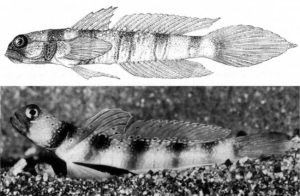
Amblyeleotris sungami. From: Klausewitz, W. 1969. Fische aus dem Roten Meer. XI. Cryptocentrus sungami n. sp. (Pisces, Gobiidae). Senckenbergiana Biologica v. 50 (nos 1-2): 41-46.
3 May 2017
A sampling of “arbitrary” names
Last week, we examined the etymology of the beryciform genus Sio, which its author described as an “arbitrary” name. This week, we take closer look at nomenclatural arbitrariness, illustrated with several examples of names that may — or may not — have meaning or significance.
What exactly is an “arbitrary” name? An arbitrary name is one in which the author coins a word or creates a word-like combination of letters that is not a latinization of an existing word (in any language), geographic location, or name of person. According to the International Code of Zoological Nomenclature (Article 11.3), “…a name may be a word in or derived from Latin, Greek or any other language (even one with no alphabet), or be formed from such a word. It may be an arbitrary combination of letters providing this is formed to be used as a word.”
In this sense, “arbitrary” does not mean “random,” as if the author were randomly selecting letters from a hat. In fact, the ICZN forbids such names. According to the Code, “The arbitrary combination of letters cbafdg cannot be used as a word and does not form a name.” Instead, “arbitrary” means that the name is based on the personal whim of the author.
Among fishes, acronyms (such as Sio) are the source for several arbitrary names. For example, there’s the rainbowfish Melanotaenia angfa, named for the Australia New Guinea Fishes Association, and the snake-eel Apterichtus ansp, named for the Academy of Natural Sciences of Philadelphia. In these examples, the acronyms can be spoken as words. But what happens if the acronym for the institution you wish to honor forms an pronounceable series of letters? In 1973, British ichthyologist N.B. Marshall named a new genus of grenadier or rattail after the Marine Biological Association of the United Kingdom (MBAUK), whose research vessel Sarsia dredged the type species. But “mbauk” or “mbaotuk” are extremely difficult to pronounce. Marshall solved the problem by playfully rearranging the acronym to form “Kumba.”
In 1969, German ichthyologist Wolfgang Klausewitz named a Red Sea goby Cryptocentrus (now Amblyeleotris) sungami. At first glance, it looks like a Japanese or Indo-Asian name, but it’s not. Klausewitz named the goby in honor of ethologist D. B. E. Magnus, who collected the type. For some reason, he decided to spell “Magnus” backwards — Sungam. Considering that Klausewitz had already named two other Red Sea fishes after Magnus — the blenny Lophalticus kirkii magnusi (now Alticus magnusi) in 1964 and the goby Biat (now Cryptocentroides) magnusi in 1968 — maybe he wanted to mix things up.
In the above examples, the arbitrary names all have a meaning (which the authors helpfully explained for us). Some arbitrary names have no meaning at all — and the authors seem proud of it.
In 1856, Charles Girard named several North American cyprinid genera — including Agosia, Algansea, Codoma, Dionda and Nocomis — after words from North American Indians, simply because they were “more euphonic than any one [he] may have framed from the Greek.” In other words, he liked the sound of them!
In 1940, George S. Myers proposed a replacement name for the neotropical characiform genus Entomolepis Eigenmann 1918, which was preoccupied by Entomolepis Bradley 1899 in Crustacea. Myers came up with Bario. It’s a “coined name without significance,” he unwhimsically said, even though the name was created on a whim.
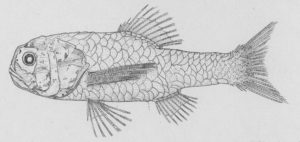
Sio nordenskjoldi. From: Moss, S. A. Melamphaidae II. A new melamphaid genus, Sio, with a redescription of Sio nordenskjöldii (Lönnberg). Dana Report No. 56: 1-10.
26 April 2017
Sio nordenskjoldii
This beryciform fish occurs in southern oceans at depths of from 200 to 3,000 meters (660 to 9,840 feet). Its generic name is “arbitrary” and presumably doesn’t have a meaning (although we may have found one). The specific name honors an explorer who survived two years stuck in the Antarctic but died crossing the street near his home.
Swedish zoologist Einer Lönnberg (1865-1942) described the species as Melamphaes nordenskjoldii in 1905. He named the fish in honor of his friend, Finnish-Swedish geologist Otto Nordenskjöld (1869-1928), who led the expedition that collected the type. In fact, it was this expedition for which Nordenskjöld became famous after he and his team were abandoned on a small Antarctic island for two years after the ship carrying food and supplies got stuck in the ice. They survived in makeshift structures and by eating the occasional seal, fish caught through holes in the ice, and lots and lots of penguins.
Nordenskjöld later explored Greenland, Chile and Peru. Despite the inherent dangers of these voyages, it was an urban accident that claimed his life. In 1928, in Gothenburg, Sweden, where he lived and taught at the university, the great explorer was struck and killed by a bus.
In 1962, Sanford A. Moss (now Emeritus Professor, Southeastern Massachusetts University), proposed a new genus for Melamphaes nordenskjoldii. He named it Sio, “an arbitrary combination of letters,” he wrote, “neuter in gender.” We found it odd — and even a bit rude — that Moss proposed an ostensibly meaningless name for the genus. As we scoured his monograph for a clue, we found one. Five of the specimens Moss examined were from the Scripps Institution of Oceanography in La Jolla, California. The institutional abbreviation of Scripps is “SIO.”
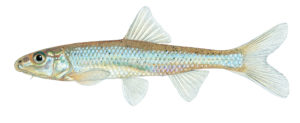
Gulf Chub, Macrhybopsis tomellerii. © Joseph R. Tomelleri.
19 April 2017
Macrhybopsis tomellerii Gilbert & Mayden 2017
Anyone who studies the freshwater fishes of North America knows and loves the scientific illustrations of Joseph R. Tomelleri. He gained fame in the late 80s and early 90s among fly-fishing anglers for his colorful and technically accurate illustrations of trout and salmonids, featured on calendars, postcards and fly-fishing publications. He added game fishes to his portfolio, and then made it his life’s mission to illustrate every North American fish species. His work has introduced countless naturalists and aquarists to the colorful diversity of fishes — especially darters (Percidae) and shiners (Cyprinidae) — that live in U.S., Mexican and Canadian waters.
Ichthyologists have sought out Joe as well. His illustrations have been featured in numerous new-species descriptions and an entire bookshelf of “Fishes of …” books and field guides. It’s through this work that I got to know Joe (electronically, at least) and benefit from his generosity. From 1996-2016, I was editor of American Currents, the quarterly publication of the North American Native Fishes Association. Whenever I needed a last-minute illustration for an article, I’d send Joe an email, asking him to share a .jpeg or .tif of a particular species. Sure enough, Joe always came through, usually within 24 hours — a wonderful thing for an editor working under a tight deadline.
It therefore gives me great pleasure to know that the artist who has illustrated nearly every North American fish species now has one named after him. Last month, Carter R. Gilbert and Richard L. Mayden described four new species of Blacktail Chub (Macrhybopsis) from North America, including the Gulf Chub, M. tomellerii, which occurs in the Pearl and Pascagoula river drainages of Mississippi and southeastern Louisiana. In honoring Joe, the authors noted how Joe’s “unsurpassed and meticulously rendered color illustrations of North American freshwater fishes have graced the pages of numerous scientific publications (including the present one), as well as books such as Fishes of the Central United States (Tomelleri & Eberle 1990) and Fishes of Alabama (Boschung & Mayden 2004).”
When I emailed Joe asking for a .jpeg or .tif of his eponymous minnow (shown here), he sent it within the hour!
Joe recently finished drawings for the upcoming book Fishes of Puget Sound and the Salish Sea. He spent 11 years on the project! And he hopes to have a “reasonable facsimile” of every freshwater species in the U.S. within the next 10 years — if the taxonomic “splitters would slow down.” (Splitting — The ETYFish Project feels your pain, Joe.)
Here’s a 5-minute video showing Joe at work illustrating a Mexican Golden Trout:
And here’s the link to his website, where you can peruse his portfolio, watch other videos (don’t miss “Truchas Mexicanas”), and buy a Tomelleri print or original for your very own.
 12 April 2017
12 April 2017
Happy National Ex-Spouse Day!
This Friday is another of those silly, made-up American holidays that celebrates things no one really celebrates. Which is why we’re celebrating by showcasing a fish whose name fits the occasion.
In 2000, Bernard J. Zahuranec published a monograph, “Zoogeography and Systematics of the Lanternfishes of the Genus Nannobrachium (Myctophidae: Lampanyctini).” In it he described seven new species of lanternfish, including Nannobrachium phyllisae from the Peru-Chile Current area of the southeastern Pacific Ocean.
“I have the pleasure of naming this species,” Zahuranec wrote, “in honor of my former wife Phyllis E. Fabian, as a token of recognition for her many years of support, which culminated in this study.”
Many fish species have been named after spouses. But this is the only fish we know of (so far) that was named after an ex-spouse.
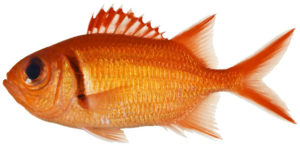
Type species of the genus, Myripristis jacobus Cuvier 1829 (photo by J. T. Williams, courtesy Wikipedia Commons). The etymology of its specific name is also worth noting. It’s a latinization of James, referring to its local name Frère-Jacques (Brother Jim) in Martinique (type locality).
5 April 2017
Myripristis Cuvier 1829
Regular “Name of the Week” readers will know that we sometimes criticize FishBase for reporting incorrect fish-name etymologies. The trouble with these “pseudo” etymologies is that FishBase is an established and otherwise reputable resource whose information is duplicated and aggregated by other online resources. That means an incorrect piece of information can take on a level of “truthiness” when it’s republished throughout the online world and shows up on multiple sites during a routine Google search. The etymology of the soldierfish genus Myripristis is another case in point.
According to FishBase, the etymology of the name is “Greek, myros, -ou = male of moray eel + Greek, pristis = saw.” The pristis half of the explanation is correct. The myros half, however, is not. Even someone unfamiliar with fishes can see there is nothing eel-like about a soldierfish.
Regular “Name of the Week” readers will also know that we constantly stress the importance of checking the original description for information about the name before hypothesizing about what the name might mean. This is something the etymology editors at FishBase obviously did not do, for if they had, they would have read the very clear words of Cuvier (here translated from the French):
“We give this genus the name of Myripristis, which means ten-thousand saws, because of all the pieces that cover the cheek and operculum, and all the scales with their serrated edges, for that is what strikes one most as the primary character of these singular fishes.”
A quick check of Brown’s Composition of Scientific Words — a beat-up copy of which is always on my desk — confirms that myrios means “ten thousand.” The Greek word can also mean “numberless,” serving as the root of the modern-day “myriad.”
 29 March 2017
29 March 2017
Bythaelurus bachi Weigmann, Ebert, Clerkin, Stehmann & Naylor 2016
This Friday, 31 March, is the 332nd birthday of the German composer and organist Johann Sebastian Bach. Late last year, a team of shark taxonomists honored Bach in the name of a new species of deep-water catshark (Carcharhiniformes, Scyliorhinidae) from the southwestern Indian Ocean.
Is there some aspect of the shark that reminded the authors of the Bach’s musical style? Does the arrangement of papillae on the tongue and roof of mouth follow a baroque style? Do its dermal denticles mirror Bach’s four-part harmonic language? Are the shark’s larger claspers somewhat reminiscent of Bach’s powdered wig?
None of the above. According to the official etymology, “The new species is named in honor of Johann Sebastian Bach (1685–1750), a musical genius and one of the greatest composers of all time.”
We contacted senior author Simon Weigmann for confirmation. Is there something Bach-like about this shark that we’re overlooking, or, perhaps, something that wasn’t included in the paper? Weigmann replied. He named this shark after Bach simply because he admires Bach’s “outstanding and superior” body of work.
Happy birthday, Johann. Enjoy your shark!
8 May 2017 UPDATE: Weigmann has co-described another shark species named after a composer: Bythaelurus vivaldii Weigmann & Kaschner 2017, in honor of Antonio Vivaldi (1678-1741), a “genius composer” of the Baroque era, in order to conveys its relationship to B. bachi.
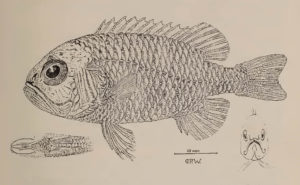
Sorosichthys ananassa. From: Whitley, G. P. 1945. New sharks and fishes from Western Australia. Part 2. Australian Zoologist v. 11 (pt 1): 1-42, Pl. 1.
22 March 2017
Sorosichthys ananassa Whitley 1945
When Australian ichthyologist Gilbert P. Whitley (1903-1975) proposed this a new genus and species of roughy (Trachichthyidae) in 1945, he did not explain the meaning of its name. But he provided an etymological clue in suggesting a vernacular, or common, name to accompany its Latin binomen. To this day, this small inhabitant of the eastern Indian Ocean off southern and western Australia is called the Little Pineapple Fish, referring to the prickly spines on its scales, similar in texture to that of a pineapple.
We googled “pineapple” to learn its scientific name — Ananas comosus. The generic name Ananas comes from the Tupí (indigenous language of Brazil) word nanas, meaning “excellent fruit.” By adding the suffix –assa, Whitely made it a diminutive, turning “pineapple” into “little pineapple,” a direct transliteration of its common name.
Figuring out “Sorosichthys” took a few minutes longer. “Ichthys,” of course, means fish. But what does “soros” mean? Several keystrokes later we came across “sorosis,” a botanical term for any multiple fleshy fruit derived from the ovaries of multiple flowers. The most famous sorosid fruit is, you guessed it, the pineapple.
Little Pineapple Fish — it’s all right there in the scientific name.
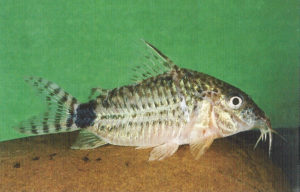
Corydoras spectabilis. From: Knaack, J. 1999. Eine weitere neue Art der Gattung Corydoras Lacépède, 1803 aus dem Mato Grosso (Pisces, Siluriformes, Callichthyidae). VDA—aktuell 1/2000: 74-79.
15 March 2017
Corydoras spectabilis Knaack 1999
This catfish occurs in the Guaporé River basin of Brazil and Bolivia. Many hobbyist references state that the specific name refers to the fish’s “showy” or spectacular appearance. While the fish may be handsome, that is not what German physician, aquarist and amateur ichthyologist Joachim Knaack (1933-2012) had in mind when he selected the name.
Knaack said that “spectabilis” refers to the “spectacular discovery, capture and other circumstances” (translation) surrounding this species. Unfortunately for us, Knaack did not explain what these “spectacular” circumstances were. So, with the help of our good friend Erwin Schraml, we contacted Corydoras aquarist Erik Schiller, who knew Knaack and discussed this species with him. According to Schiller, the name refers to the Knaack’s surprise and delight in finding several specimens one year when in an earlier year he had found only one. With only one speciemen, Knaack suspected the fish was a hybrid between C. haraldschultzi and either C. caudimaculatus or C. guapore. With many more specimens, he realized he had a new species.
In this case, “spectacular” may be an incorrect interpretation of “spectabilis.” It should be noted that the Latin adjective can also mean “notable” and “remarkable,” which the circumstances involved in the discovery of this species certainly were.
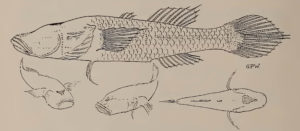
Milyeringa veritas. From: Whitley, G. P. 1945. New sharks and fishes from Western Australia. Part 2. Australian Zoologist v. 11 (pt 1): 1-42, Pl. 1.
8 March 2017
Truth, justice and blind cave gudgeons
It’s one of the most interesting and creative name pairings in ichthyology. Two blind cave gudgeons from Australia, One named for “truth,” the other for “justice.” Here’s the etymological story.
Milyeringa veritas is an eyeless gudgeon discovered at the bottom of a freshwater well (bored into coral and limestone) in Western Australia in 1944. British-born Australian ichthyologist Gilbert P. Whitley (1903-1975) named both the genus and species a year later. The meaning of the generic name is quite clear, referring to the location (Milyering, Yardia) where the cave and its gudgeon occurs. The specific name, veritas, means “truth,” but Whitley did not explain how the name applied to the gudgeon until at least 1951, when he penned a popular article for The Australian Museum Magazine. Like “Truth,” Whitley said, the gudgeon was “found at the bottom of the well,” alluding to a quote attributed to the pre-Socratic Greek philosopher Democritus (460 BC – c. 370 BC): “Truth lies at the bottom of a well, the depth of which, alas! gives but little hope of release.” (Another version: “Of truth we know nothing, for truth lies at the bottom of a well.”)
In 2013, a team of researchers — Helen K. Larson, Ralph Foster, William F. Humphreys and Mark I. Stevens — described another species of blind Milyeringa from Barrow Island, Western Australia. “As truth and justice are supposed to go together,” the authors wrote, “we name this species justitia, from the Latin for justice, in the hope that justice helps the species to survive on Barrow Island, which has been an oilfield since 1967 and is most recently the site of the Gorgon Gas Hub development.”
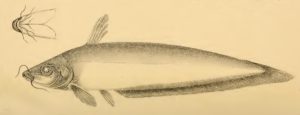
Neosilurus hyrtlii. From: Steindachner, F. 1867. Über einige Fische aus dem Fitzroy-Flusse bei Rockhampton in Ost-Australien. Sitzungsberichte der Mathematisch-Naturwissenschaftlichen Classe der Kaiserlichen Akademie der Wissenschaften v. 55 (1. Abth.): 9-16, Pl. 1.
1 March 2017
Neosilurus Steindachner 1867 and Neosilurus Castelnau 1878
The name is bland and undescriptive. The fact that it was seemingly coined twice for the exact same species is quite amazing.
Austrian ichthyologist Franz Steindachner (1834-1919) proposed the name Neosilurus for a genus of eeltail catfishes native to Australia and New Guinea. It translates as neo-, new, and silurus, from the Greek silouros, a word of uncertain origin historically applied to a catfish. Steindachner did not explain why he proposed this name. Maybe Steindachner believed the type species, N. hyrtlii, superficially resembled the Wels Catfish, Silurus glanis, of Europe. Or maybe the name simply (and unimaginatively) means “new catfish.”
Eleven years later, French naturalist François de Laporte de Castelnau (1810-1880) published a paper called “Australian fishes. New or little known species.” In it he provided descriptive accounts of the genus Neosilurus and a species named Neosilurus australis. Castelnau did not mention that Steindachner had already proposed the genus.
A year after Castelnau’s death, naturalist William Macleay concluded that Castelnau, seemingly oblivious of Steindachner’s description from 1867, had described Neosilurus as a new genus. This made Neosilurus Castelnau a junior primary homonym of Neosilurus Steindachner. Since no two animal taxa can have the same name, Macleay proposed a replacement: Cainosilurus. Today, Cainosilurus is considered a synonym of Neosilurus Steindachner and N. australis a synonym of N. hyrtlii.
There are two possibilities here. Accepted wisdom is that Castelnau independently coined the same generic name for the same species of catfish that Steindachner had studied and published on 11 years earlier. Possibility #2 is that Castelnau was aware of Steindachner’s Neosilurus and was adding a new species (N. australis) to the genus. Let’s examine both possibilities.
It’s not hard to imagine that Steindachner’s Austrian paper never reached Castelnau in Australia. But it seems an improbable coincidence that Castelnau devised the same name. (This is nothing like Darwin and Wallace, who, confronted with the same overwhelming evidence, independently theorized about evolution.) Coining a name is a personal, subjective exercise. Names often reveal more about the describer than the taxon being described. Yet, seemingly, there was Castelnau, examining his catfish. “Behold, a new Silurus,” he might have said (in French). “And that is what I — and all of science — shall call you for eternity. Neosilurus!”
In support of this possibility is the fact that Castelnau many times used the neo– prefix in coining generic names. Neoarius. Neoatherina. Neoblennius. Neocarassius. Neoceratodus. Neochaetodon. Neocirrhites. Neogunellus. Neolethrinus. Neomesoprion. Neomordacia. Neomyripristis. Neoniphon. Neoodax. Neoplatycephalus. Neoplotosus. Neorhombus. Neoscopelus. Neosillago. Neosphyraena. Neosudis. Neotephraeops. Neotrygon. So why not Neosilurus? Adding neo– to an existing generic name is a quick and easy way to delineate its resemblance and/or relationship to an existing group of fishes.
Evidence against the “new” possibility is that Castelnau proposed three other genera in this paper. For all three names he explicitly or implicitly indicated that they were new. However, there is no indication of newness in his account of Neosilurus. Based on this internal (and admittedly inconclusive) evidence, one could conclude that Castelnau’s Neosilurus was not a genus novum.
Here’s another wrinkle: In 1875, Castelnau described an Australian catfish he called Silurichthys australis. According to the Catalog of Fishes and other references, this is a separate species from his Neosilurus australis of 1878. (Today, both are treated as junior synonyms of N. hyrtlii.) However, we’re not convinced that Castelenau intended them as different taxa. In 1878, Castelnau said that Neosilurus “comes near” to Silurichthys, so it is reasonable to conclude that he simply moved his S. australis of 1875 into a different genus — Neosilurus — in 1878. The type specimens of both putative taxa (both from Queensland) are now lost, so there’s no way of knowing for sure. A side-by-side reading of the two accounts is inconclusive; some characters match, others do not.
Our guess is that Neosilurus australis was Castelnau’s new name for Silurichthys australis. The jury is still out on whether Castelnau coined Neosilurus as new, but based on his frequent use of the neo– prefix, we are leaning that way. We will likely never know for sure. As catfish taxonomist Isaäc J. H. Isbrücker told us upon reviewing an early draft of this account, “It’s hard to reliably read the minds of dead authors.”
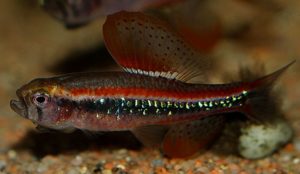
Black Darter Tetra, Poecilocharax weitzmani. www.tropical-fish-keeping.com
22 February 2017
Stanley H. Weitzman (1927-2017)
A giant in ichthyology and a true gentleman, Stanley H. Weitzman, passed away last week, just one month shy of his 90th birthday.
Weitzman’s interest in fishes began with a goldfish some time in third grade. His interest intensified at the home of a classmate, whose father maintained several aquaria in his garage. At this time he met his future wife and frequent collaborator, Marilyn. (Trained in botany, she typed his papers, learning to become an accomplished ichthyologist herself.)
During World War II Stan joined the Navy, spending a year at sea. While passing through the Panama Canal, he sat on the foredeck and watched small fishes jumping out of the water. They were freshwater hatchetfish, Gasteropelecus maculatus, which later became the subject of his Master’s thesis. Weitzman would eventually make the study of neotropical characiforms the mainstay of his career (although it should be noted he was an authority on deep-sea stomiiform fishes as well).
Weitzman was also an accomplished aquarist, breeding many of the small characiform fishes he was studying. In fact, he was equally at home hanging out with members of his local aquarium club (the Potomac Valley Aquarium Society) as he was with fellow ichthyologists. In 2002, I had the pleasure of co-judging the PVAS fish show with Dr. Weitzman and was impressed by the time and care he took in judging all the entries.
For a 2007 Copeia article, Dr. Weitzman was asked to assess what he believed were his greatest scientific accomplishments:
- His doctoral dissertation on the osteology of Brycon meeki, which became a standard reference on the osteology of fishes in general.
- Co-authoring “Phyletic Studies of Teleostean Fishes, with a Provisional Classification of Living Forms” (1966), a seminal work in fish systematics.
- His 1974 revision of stomiiform fishes, the first large, anatomically organized cladistic paper on fishes.
- A 1983 paper (authored with William L. Fink) that completely changed the phylogeny and classification of neon tetras.
- A 1985 cladistic study (authored with Sara Fink) on glandulocaudine (now stevardiine) tetras that paved the way for numerous succeeding (and revolutionary) papers on characiform phylogeny.
All told, Dr. Weitzman has more than 300 scholarly and aquarium papers and articles to his credit. He has described or co-described 15 new genera and 90+ new species. Expect his name to be attached to several new taxa that are currently being described.
(Speaking of new species, Weitzman [and his mentor George S. Myers] were the first to describe the Cardinal Tetra in 1956. They called it Hyphessobrycon cardinalis. However, publisher Herbert R. Axelrod rushed a concurrent description by Leonard P. Schultz into print, beating out Myers’ and Weitzman’s paper by one (!) day. That’s why the Cardinal Tetra is now called Paracheirodon axelrodi instead of P. cardinalis.)
Seven fishes have been named after Dr. Weitzman: two tetras, two crenuchids, an anablepid livebearer, a Corydoras catfish, and a marine sternopterychid called a pearlside. Shown here is the first of these seven fishes, the crenuchid Poecilocharax weitzmani of Brazil, Colombia, Peru and Venezuela, described by Jacques Géry in 1965.
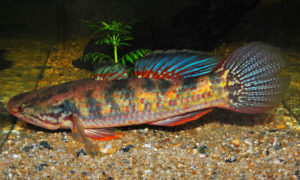
Giuris margaritacea. Photo by Keith Martin. From: Fishes of Sahul, Journal of the Australia New Guinea Fishes Association 34 (4), Dec. 2016.
15 February 2017
Giuris margaritacea (Valenciennes 1837)
The Snakehead Gudgeon occurs in a variety of habitats — rivers, swamps, coastal streams and floodplains over mud bottoms — from Madagascar to New Guinea, Australia and islands of Melanesia. With such a wide distribution, it is possible that what we call the Snakehead Gudgeon may consist of multiple species.
We do not know what Giuris means. Palaeontologist-ichthyologist Henri Émile Sauvage (1842–1917) proposed the name as a subgenus of Eleotris in 1880, but he did not indicate why he chose that particular epithet. Physician-naturalist Francis Hamilton-Buchanan (1762–1829) used the same name (Gobius giuris, now Glossogobius giuris) for a goby from the Ganges River of India in 1822, but also did not explain his reason for the selection. Hamilton-Buchanan often used local Indian names for the Latin names of the fishes he described, but he did not indicate whether “giuris” had a local provenance. [Actually, it did; see entry for 15 November, above.] One might guess that Sauvage imagined a kinship between his Eleotris subgenus and the Indian goby (at that time, both eleotrids and gobiids were both considered “gobies”), but that is purely speculation.
In contrast, the meaning of “margaritacea” is quite obvious. It means “pearly” and refers to what Valenciennes perceived as pearl-like white spots on the sides. “The color is brown,” he wrote, “with white spots and pearls on the sides, forming three distinct little rows” (translated from the French).
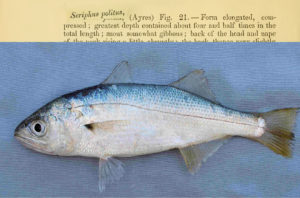
Queenfish, Seriphus politus, caught off the Oceanside Pier, Oceanside, California, May 2006. Length: 15.0 cm (5.9 inches). © John Snow, www.mexican-fish.com
8 February 2017
Seriphus Ayres 1860
We’re pretty sure that ichthyologist-physician William O. Ayres (1817-1887) did not intentionally coin an enigmatic fish name to frustrate future researchers, but that’s precisely what he’s doing to us.
In 1860, Ayres proposed the name Seriphus for a genus of croakers (family Sciaenidae) commonly called “Queenfish” along the Pacific Coast of California. He named the type species (and only species of the genus) politus, meaning polished, possibly referring to its silvery sides and belly. Ayres described the species from three specimens acquired at a San Francisco fish market, so he probably never saw the fish in life and probably did not know it was a “croaker,” so named for the noises members of the family can make by vibrating muscles against their swim bladder. It was just a dead fish that needed a name. So Ayres gave it one. But he did not explain why Seriphus was his choice.
The dean of American ichthyology, David Starr Jordan — no slouch when it came to fish-name etymologies — was puzzled by the name as well. In The Fishes of North and Middle America, Jordan (and his co-author Evermann) listed three possible explanations for the name:
- an island in the Grecian Archipelago
- a small winged insect
- a kind of wormwood
Then he added: “the allusion in any case not evident.”
We took a closer look at all three explanations to see if there was a clue, a connection, or an obscure piece of information that could connect the allusion to the fish in question. SPOILER ALERT: Despite hours of research and several intriguing but ultimately dead-end leads, Seriphus remains a mystery.
Seriphus, it is true, is a Greek island in the Aegean Sea. (Seriphus is the Latin spelling; Serifos is the Greek.) In Greek mythology, Serifos is where Danaë, the only child of King Acrisius of Argos, and her infant son Perseus, washed ashore after her father, believing that his own grandson would kill him, set them adrift at sea in a wooden chest. When Perseus later returned to Serifos as an adult, he turned Polydektes, the king of the island, and his retainers into stone as punishment for the king’s attempt to marry his mother by force.
None of this seems to apply to a fish found in a San Francisco fish market. But we were intrigued by another fact about the island: according to Pliny, its frogs could not croak. The expression “Seriphian frog” was used as a popular proverb in ancient times to denote a person who refused to talk. Did Ayres associate the island’s non-croaking frogs with his dead (non-croaking) croaker? Even if Ayres knew about his fish’s croaking ability, that would be one very long stretch of an etymology.
Regarding possible explanation #2, a “small winged insect,” nothing pans out. There’s “serphos,” an ancient Greek word for a small winged insect, possibly a gnat. And there’s Syrphus Fabricius 1775, a genus of hoverflies. (Entomological literature also records the name as “Sterphos” and “Seriphos.”) And one Greek proverb alludes to “Syrphus” possessing a sting. We do not see any connection between a croaker and a fly that hovers over flowers. (In addition, we found a reference to “Seriphos,” the so-called “sea cicada,” reportedly a kind of lobster.)
Which brings us to #3, a kind of wormwood. This one, we believe, has the highest probability of reflecting the meaning of the name, but the evidence is thin and circumstantial. The name Seriphus is very close to Seriphium, a genus of asters, whose generic name dates to Linnaeus (1753); the type species S. cinereum, sometimes called the Sea Wormwood, is native to the Cape of Good Hope. Note that the specific name “cinereum” means ash-colored. Was Ayres making a connection between the color of the plant and the silvery color of his croaker?
We doubt that Ayres looked at his dead croaker and thought, “Hey, that reminds me of a plant from Africa!” But it’s possible that the fish reminded him of a species or genus of aster whose native range is much closer to the fish’s type locality in San Francisco Bay. Artemisia is a genus woody plants grown chiefly for their silver or grey and often aromatic foliage. Ayres may have been familiar with the Silver Sagebrush, also known as the Silver Wormwood, Artemisia cana, a low, multi-branched perennial of the western United States. Other possibilities are the Great Basin Sagebrush (A. tridentata) and California Sagebrush (A. californica). Maybe it’s just a coincidence, but these plant species had once been placed in an Old World genus whose name should look familiar: Seriphidium Besser (ex Hook) 1828. Is this where Ayres got Seriphus?
Here’s another seeming coincidence: Ayres noted that his Seriphus croaker is “very closely allied” to Johnius Bloch 1793, a genus of croakers from the other side of the Pacific. Like Seriphus and its putative botanical cognates Seriphium and Seriphidium, Johnius (the fish) has a corresponding namesake in the plant kingdom as well — Johnia Roxburgh 1820, a genus of small trees from India. Both Johnius and Johnia were likely named after Christoph Samuel John (1747–1813), a German missionary in the Danish colony of Tranquebar (now called Tharangambadi) in India, who collected natural history specimens for Bloch and Roxburgh. Did Ayres give his fish a plant-like name because it’s related to a fish that also has a plant-like name? Probably not, but these are the kinds of things we consider when investigating enigmatic names.
Whatever the explanation, it seems that “Seriphus” was a last-minute replacement. Check any original hard copy of the Proceedings of the California Academy of Sciences (Series 1, v. 2, 1858-1862) and you’ll see that the name “Seriphus politus” has been hand-glued over another name (see photo) — “Corvina polita.” (Corvina is the Mexican name for croakers.) We don’t know why Ayres made the change. Our guess is that he realized that the name had already been proposed by Cuvier for a croaker in 1829, and/or that it’s preoccupied in birds (Corvina Hahn 1822). Any notes or labels that might have accompanied Ayres’ type specimen and could have provided any etymological clues were all lost or destroyed in the San Francisco earthquake of 1906. On the meaning of Seriphus, Ayres is a Seriphian frog.
For now, we’re placing Seriphus in our “cold-case file” and will return to it every now and again. If you have any information, any theories, any clues, please email the ETYFish tip line at chris (at) etyfish (dot) org. Thank you.
 1 February 2017
1 February 2017
Eviota Jenkins 1903
Late last year, David W. Greenfield and Richard Winterbottom published “A key to the dwarfgoby species (Teleostei: Gobiidae: Eviota) described between 1871 and 2016” in the Journal of the Ocean Science Foundation, vol. 24, pages 35–90. It’s an open access publication with dozens of color photos of these diminutive but dazzling fishes. One passage from the introduction made us do a double take:
“The genus was described by Jenkins (1903), based on Eviota epiphanes from Hawai‘i. No etymology was given, but Eviota is a surname, or first name, particularly in the Philippines.”
While it is true that Jenkins did not explain the etymology, and while we do not contest that Eviota may be a surname in the Philippines, we can say with 100% confidence that Jenkins did not name the genus after a Filipino. In fact, we were able to figure out the etymology of Eviota without even consulting a dictionary.
The first part of the name, ev-, is a latinization (for euphony) of the Greek prefix eu-, meaning “good” or “well.” It’s often used as an intensifier, i.e., “very.” The second part of the name is from iota, the smallest letter in the Greek alphabet and often figuratively used to describe anything small or insignificant. Several small fishes include “iota” in their name: the catfish Hisonotus iota; the squirrelfish Sargocentron iota; the poeciliid Scolichthys iota; the eleotrid Thalasseleotris iota; and the characid genus Iotabrycon.
It should come as no surprise that dwarfgobies, being very small, have a name that means “very small.” In fact, when Jenkins proposed the genus in 1903, he believed that the type species, Eviota epiphanes, measuring just 1.0-1.9 cm in length, was the “smallest vertebrate that has up to this time been described.”
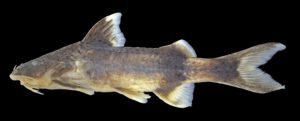
Glyptothorax pictus, paratype, 76.1 mm SL; Borneo: Katingan River drainage. Photo by Heok Hee Ng.
25 January 2017
Glyptothorax famelicus Ng & Kottelat 2016 and Glyptothorax pictus Ng & Kottelat 2016
Last November, Heok Hee Ng and Maurice Kottelat published a monograph, “The Glyptothorax of Sundaland: a revisionary study (Teleostei: Sisoridae)” in the journal Zootaxa 4188 (1): 001–092. In it they described six new species of sisorid catfishes. Unfortunately, the etymology section for two of these new species was overlooked and not included in the final publication. We contacted the senior author and, for the record, provide the missing etymologies here:
Glyptothorax famelicus: The specific epithet is the Latin adjective meaning “suffering from hunger”, in allusion to the very slender body and caudal peduncle of this species.
Glyptothorax pictus: The specific eithet is the conjugated form of the Latin verb “pingo” meaning “to paint”, referring to its distinctive color pattern among Sundaic congeners except for G. decussatus, featuring prominent dark vertical bars at level of adipose-fin base and base of caudal fin.
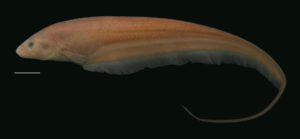
Eigenmannia correntes. From: Campos-da-Paz, R., and I. R. Queiroz. 2017. A new species of Eigenmannia Jordan and Evermann (Gymnotiformes: Sternopygidae) from the upper rio Paraguai basin. Zootaxa 4216 (1): 73-84.
18 January 2017
Eigenmannia correntes Campos-da-Paz & Queiroz 2017
Today we belatedly celebrate the New Year with the first new fish species of 2017 — Eigenmannia correntes, a glass knifefish (Gymnotiformes) from Brazil.
The new species is described from tributaries of rio Correntes — hence its specific name — a major affluent of the rio Piquiri system, upper rio Paraguai basin (Mato Grosso and Mato Grosso do Sul states, Brazil).
The generic name Eigenmannia dates to Jordan & Evermann 1896 and Carl H. Eigenmann (1863-1927), for his “excellent work” on the freshwater fishes of South America. (It’s actually a replacement name for Cryptops Eigenmann 1894, preoccupied by Cryptops Leach 1814 in Myriopoda, Cryptops Schoenherr 1823 and Cryptops Solier 1851 in Coleoptera.)
An average of 380 new fish species have been described each year between 1997 and 2015. Last year was slightly above average. According to our friends at Welt der Fische / World of Fishes, 422 new species (or subspecies) were described in 2016, plus 42 new genus-level names, and three replacement names.
The top 5 families were:
- Gobiidae (gobies) … 50 new species
- Cyprinids (carps & minnows) … 47 new species
- Loricariidae (armored suckermouth catfishes) … 28 new species
- Cepolidae (bandfishes) … 21 new species
- Characidae (tetras, etc.) … 21 new species
With the ever-increasing use of DNA in species analysis, new exploration into unexplored aquatic habitats, the acceptance of less-restrictive species concepts, and the proliferation of online taxonomic journals (some legitimate, some predatory, all needing to be filled with papers), we expect these numbers to continue — if not climb — in 2017.
Let’s hope that all of the names are properly explained, and that many of worth writing about.
Happy New Year!
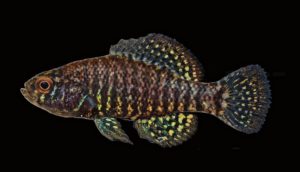
Elassoma boehlkei. © Fred C. Rohde.
11 January 2017
Elassoma boehlkei Rohde & Arndt 1987
Today, 11 January, we commemorate the 87th birthday of American ichthyologist James E. Böhlke (1930-1982). Born in Buffalo, Minnesota, a farming community 64 km northwest of Minneapolis, he began keeping tropical fishes in aquaria as a teenager and was immediately fascinated by them. His high-school science teacher told him about the large collection of fishes at the Academy of Natural Sciences in Philadelphia. In his junior year of high school, Jim decided to become an ichthyologist, and to one day work at the Academy.
Jim began a correspondence with Henry Weed Fowler, the Academy’s long-time curator of fishes. In exchange for information from Fowler, Jim agreed to collect and send him fishes from Minnesota. The first fish he sent — the Northern Pearl Dace, Margariscus nachtriebi — delighted Fowler for it was new to the Academy’s collection. More fishes followed.
Jim researched his college options and decided there was only one school he could attend: Stanford University, studying under famed ichthyologist George S. Myers. Jim wrote to Myers, requesting information in exchange for Minnesota fishes. Myers took him under his wing and helped him gain admittance to Stanford.
Jim’s undergraduate work was unremarkable. (He had to take Western Civilization four times!) But he excelled, even as an undergraduate, in Myers’ graduate ichthyology lab. (To save money, he slept on a cot in the museum’s basement and showered in the school’s gymnasium.) He published his first paper during his junior year in college in 1949. By the time he earned his Ph.D. in 1954, he had established three major pursuits that would dominate the rest of his career: eels, South American characiforms, and the curation and collection of fishes.
1n July 1954, Jim was about to join the U.S. Fish and Wildlife Service when he received an unexpected phone call from the Academy of Natural Sciences in Philadelphia: Would he be interested in moving east and joining a three-year project collecting and studying the fishes of Nassau? Since working at the Academy had been his dream since a teenager, he of course said yes.
Upon arriving at the Academy, he discovered that the fish collection was disorganized and largely inaccessible. Fowler, nearing his 60th year at the Academy, was now too old — and perhaps no longer interested — in properly curating the immense collection of fishes he had amassed. Jim was the right man for the job, a job that took over 20 years to complete. Even his children helped, counting fishes, typing catalog cards and putting labels in jars. Fowler worked in a nice corner office on the fourth floor. Jim toiled in the basement.
Failing health caused Fowler to leave the Academy in 1962. (He died three years later.) Jim took over as Chairman of the department, making the Academy’s fish collection one of the finest in the world. During that time he published over 120 papers on diverse groups of fishes and topics (characins, gobies, blennies, catfishes, eels, cusk eels, stargazers) and one classic book: The Fishes of the Bahamas (1968).
Over 20 new fish taxa have been named after Jim. We could have selected any of them to feature here. But we selected the name proposed by our good friend Fritz Rohde and his good friend Rudy Arndt for the Carolina Pygmy Sunfish, Elassoma boehlkei (Elassomatidae), known only from the Waccamaw and Santee River drainages of North and South Carolina (USA). Rohde and Arndt honored Jim for his “many contributions to ichthyology and his long-standing interest in the genus Elassoma.”
Jim described the Okefenokee Pygmy Sunfish, E. okefenokee, in 1956. In 1960, Jim led the family on a month-long search for new Elassoma species. According to Jim’s wife Eugenia (1928-2001), an accomplished ichthyologist herself:
“This was the first family project to include all five Böhlkes; [we] traveled throughout 14 southern states in a Volkswagen microbus, stopping at innumerable small creeks, underpasses, and roadside ditches where all hopped out to dip-net small freshwater fishes. The children, then three, five, and seven years old, proved to be nimble collectors, small fingers most efficient at gently picking fishes only a few millimeters out of the net.”
In 1980, Jim was spending nearly every waking hour studying fishes and writing manuscripts. But his life took a sad and tragic turn.
“Alas, his health and well-being deteriorated,” Eugenia wrote, “as alcohol, long consumed in celebration of his life and career … now overpowered him and made his life unmanageable. He finally overcame years of denial and acknowledged his problem in January of 1982 and, with the help and encouragement of family, friends, and colleagues, he started recovery.”
Two days before leaving on a long-postponed trip to Hawaii to study eels, Jim learned that the Academy no longer desired his services. Confident that he would be reinstated upon his return, Jim went on the trip anyway. But the Academy administrators upheld their decision.
“Jim could not envision any life,” Eugenia continued, “other than continuing that which he had lived the previous 28 years. Thus he ended his life early on the morning of 25 March 1982 — a gunshot wound to the head while sitting in his cherished home laboratory — a great tragedy and loss to family, friends, and colleagues.”
4 January 2017 (revised 4 March 2019)
“Rhynchobatus compagnoi Last & Kyne 2016”

Turn to page 69 of the new and impressive book Rays of the World and you will see a full page devoted to this species of wedgefish (Rhinopristiformes, Rhinidae) from Signapore and Indonesia. But something is very, very wrong with the entry. “Rhynchobatis compagnoi Last & Kyne 2016” is not the fish’s name. Its true name is Rhynchobatus cooki Last, Kyne & Compagno 2016.
Last year, many new ray taxa were described in the journal Zootaxa in preparation for the December publication of the book. This species was one of them. According to Peter Last (pers. comm.), “R. compagnoi” was a manuscript name in honor of Leonard J. V. Compagno, a legendary figure in chondrichthyan taxonomy. But Compagno insisted that the fish be named for the late Sidney F. Cook (1953-1997), a “pioneer in shark conservation who participated in surveys of chondrichthyan fishes in South-East Asia at the time specimens were collected.” Compagno’s suggestion made it into the Zootaxa description but was overlooked during the publisher’s rush to bring the book to press. (Notice that Compagno was added as a co-author of the name.) However, the correct name (“cooki”) is listed in a table on p. 757. But the incorrect name is listed in the index.
The catshark Cephaloscyllium cooki Last, Séret & White 2008 is also named after Cook. According to the authors, Cook’s “energy, dedication and contribution to shark conservation is sadly missed.”
“Rhynchobatus compagnoi Last & Kyne 2016” is considered an “unavailable” name for nomenclatural purposes.